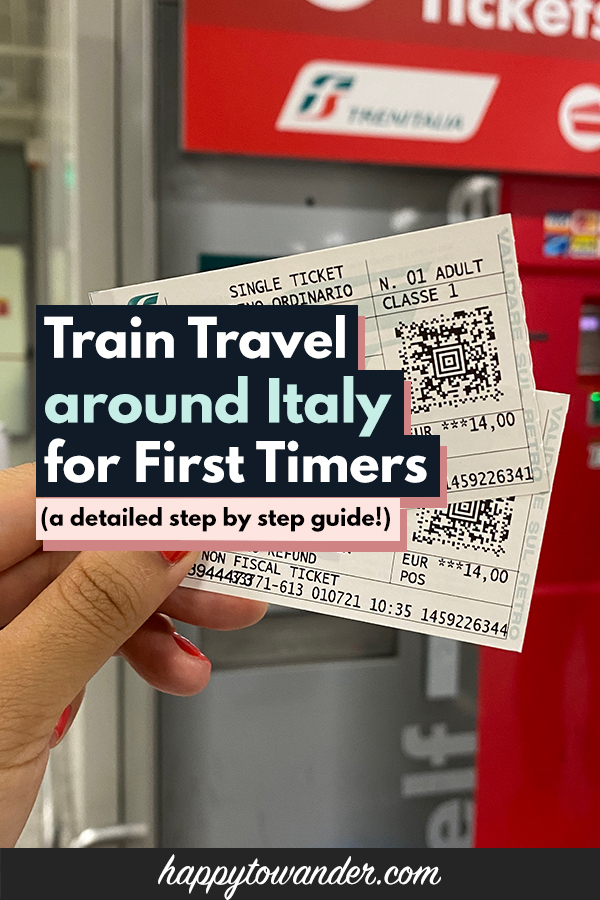*FYI - this post may contain affiliate links, which means we earn a commission at no extra cost to you if you purchase from them. Also, as an Amazon Associate I earn from qualifying purchases. Check out our Privacy Policy and Disclosure. for more info.
Travelling Italy by train is a bucket list dream for a lot of people, and while I’m personally a huge fan, I can admit it has its flaws.
Loaded with traps and intricacies that can catch a lot of first timers off guard, taking the train in Italy isn’t the most intuitive thing, which is why I’m going to walk you through it step by step today in so much detail, you’ll pause to wonder who hurt me.
So, read on for a detailed guide to Italian trains that includes…
- Italian Rail Providers
- Types of Trains in Italy
- Italian Train Ticket Types & Classes
- How to Buy Italian Train Tickets
- How to Navigate Italian Train Stations
I hope you find it helpful!
A Brief Introduction to the Italian Rail System
Let’s start with some basics on taking the train in Italy, which includes over 2000 stations scattered across 24,000+ km of tracks!
Rail Providers in Italy
To start, it’s important to distinguish between train companies that actually operate the trains, and 3rd party ticket sellers, as this often causes confusion among first timers, so to clarify:
- There are train operators (e.g. Trenitalia and Italo) that sell tickets AND actually run the trains – it’s usually best to buy directly from them because their staff are the ones you’ll encounter on board and at stations
- There are also ticket sellers (e.g. Trainline, Omio or ItaliaRail) who JUST sell tickets and do not have anything to do with the operation of the trains – they offer great search capabilities, allowing you to search across operators, and are generally easier for tourists to use… but they sometimes charge a small service fee
Whether you buy tickets directly or through a 3rd party is up to you, but do know that tickets purchased through a legitimate 3rd party WILL be valid – I’ve travelled many times with tickets purchased via Trainline and Omio, so don’t worry about them being scams.
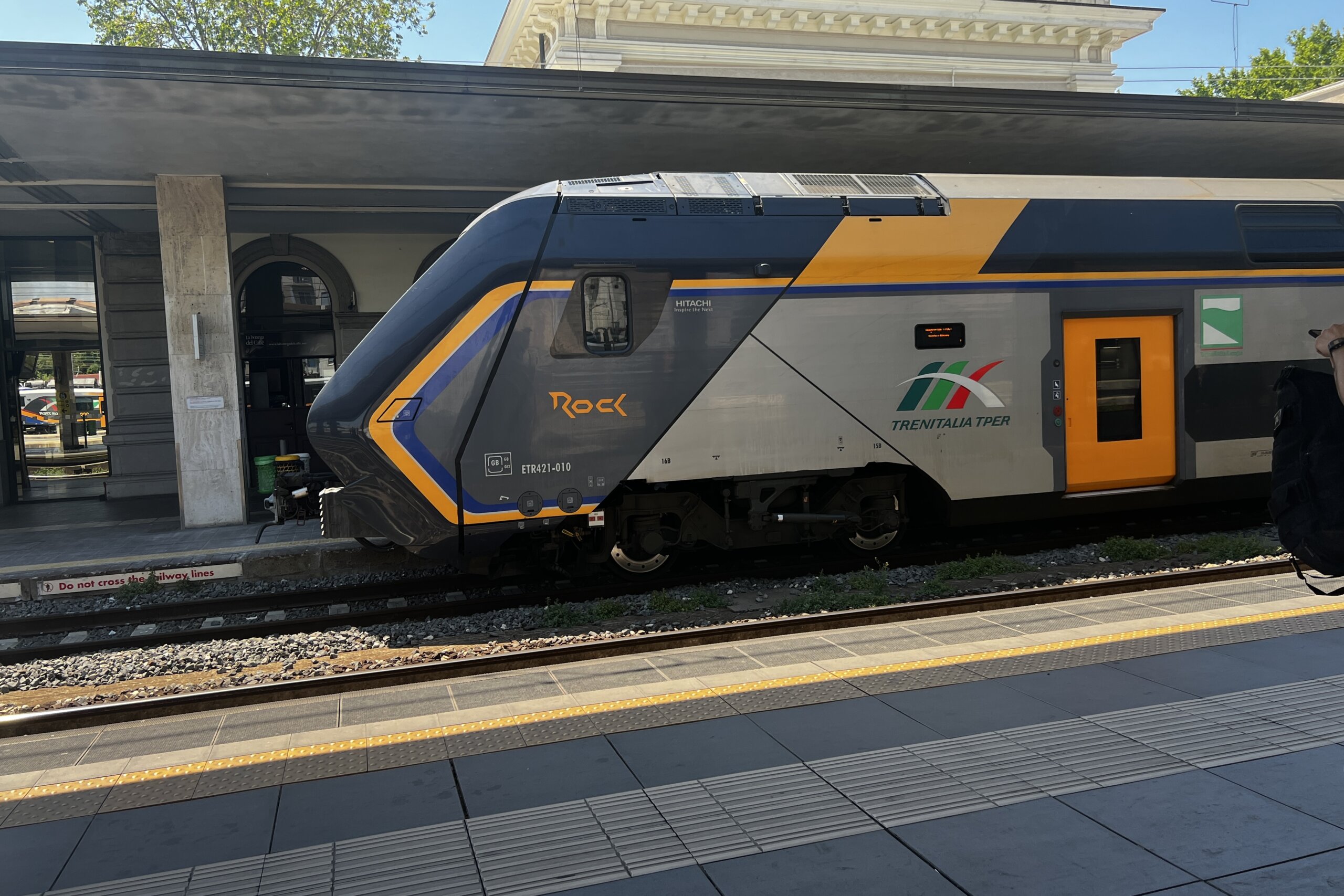
For trains within Italy, there are two main train operators that offer high speed options:
- Trenitalia, which operates Intercity & Le Frecce Trains (Frecciarossa, Frecciargento, Frecciabianco), as well as Regionale (Regional) trains, including those from Trenord and Ferrovie del Sud Est (who have their own branding, but are owned by Trenitalia)
- NTV (Nuovo Trasporto Viaggiatori), best known for theIr Italo branded high speed trains which currently covers 54 cities with 62 stations across Italy
IMPORTANT TO KNOW: Trenitalia and Italo operate completely separately so they will have their own websites, staff, and ticket machines at stations, so again, if you want to compare options across both companies, you will need to use a 3rd party app like Trainline, Omio or ItaliaRail.
In addition to these two main companies, there are also smaller private companies that run regional routes within Italy like…
- Ente Autonomo Volturno, best known for the Circumvesuviana Railway between Naples and Sorrento
- Ferrovie Appulo Lucane, which operates routes in Puglia and Basilicata
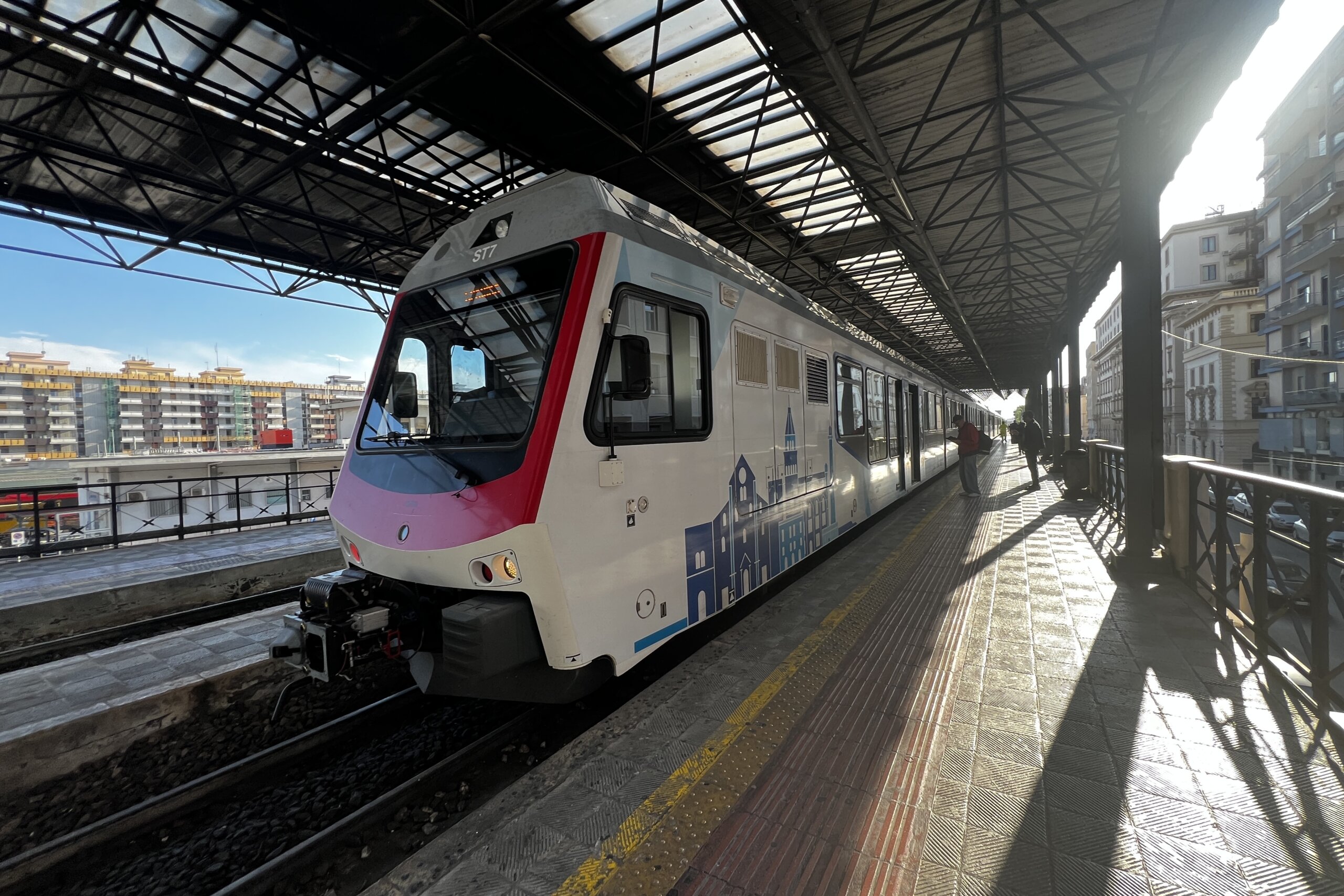
As well as some companies that operate on international routes, like…
- SBB, which runs some direct EuroCity trains to Switzerland
- SNCF, which runs some trains to France
- DB, which runs some trains to Germany
- ÖBB, which runs some trains (including a night train!) to Germany/Austria
These companies will NOT show up if you’re searching on Trenitalia or Italo as they are run by different companies, so just keep that in mind.
NOTE: This post will be focusing mostly on domestic trains within Italy, but many of the overarching tips will still apply if you’re taking the train between Italy and another country.
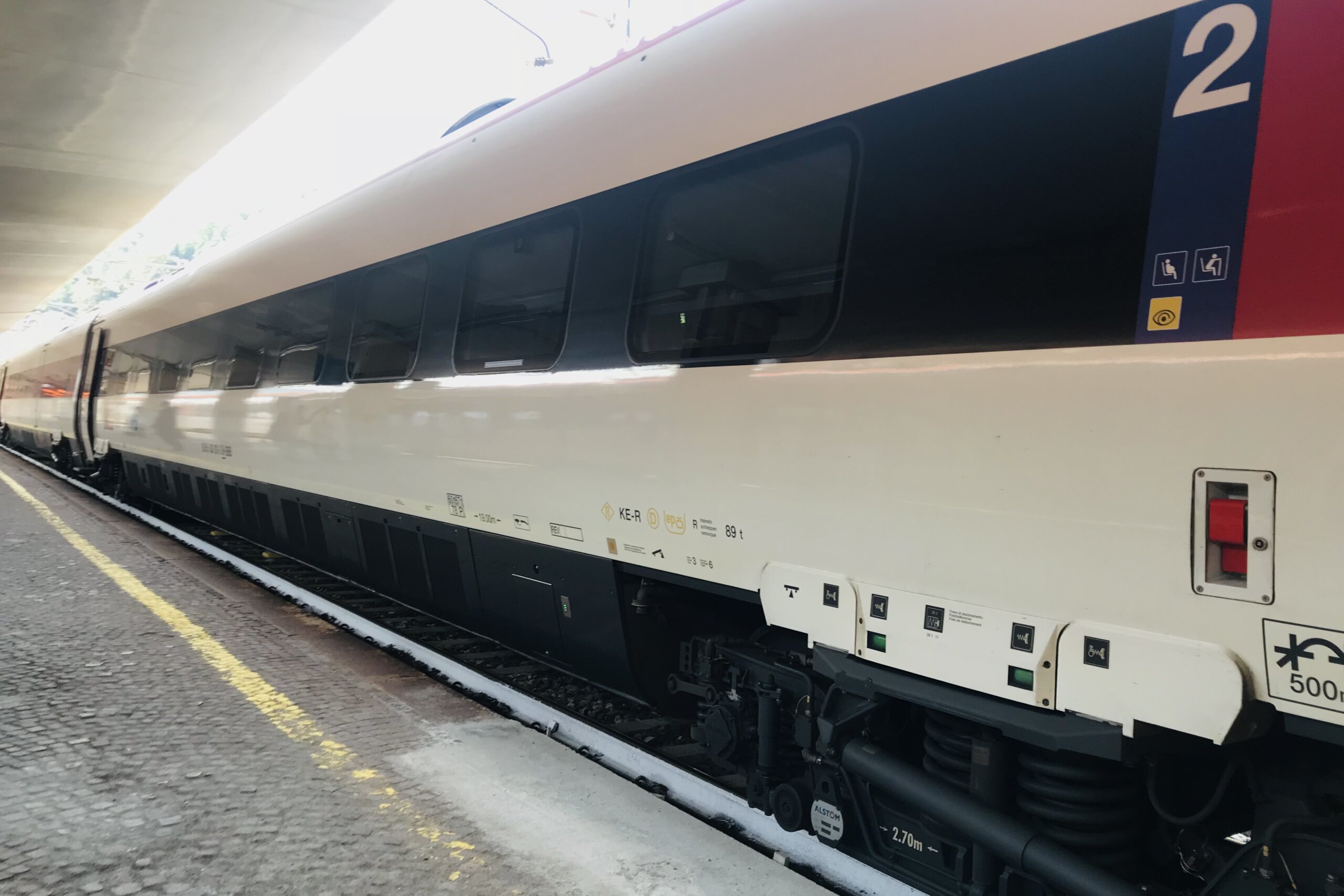
Types of Trains in Italy
Broadly speaking, we can divide Italian trains into two three categories:
- High Speed
- Regional
- And Local, such as Commuter or Metro trains
Understanding the difference between these is important, as they each vary in journey time and cost, so I’m going to run through the most common ones.
First – High Speed Trains in Italy are used to connect larger cities and are therefore quicker, but typically require booking in advance, with reservations being a good idea in busy periods.
In terms of high speed trains, the main options are…
- Intercity and Le Frecce Trains (Frecciarossa, Frecciargento, Frecciabianco) with Trenitalia (which go up to 300km/hour for Frecce trains, and up to 200km/hour for Intercity)
- Italo trains (which go up to 300km/hour)

In contrast, Regional Trains do not have reserved seats and prices are fixed, so do not change depending on when you buy them. These are usually marked with R or RV (Regionale Veloce) on train schedules, you may also sometimes encounter…
- including IR (Interregionale)
- D (Direct)
- E (Express)
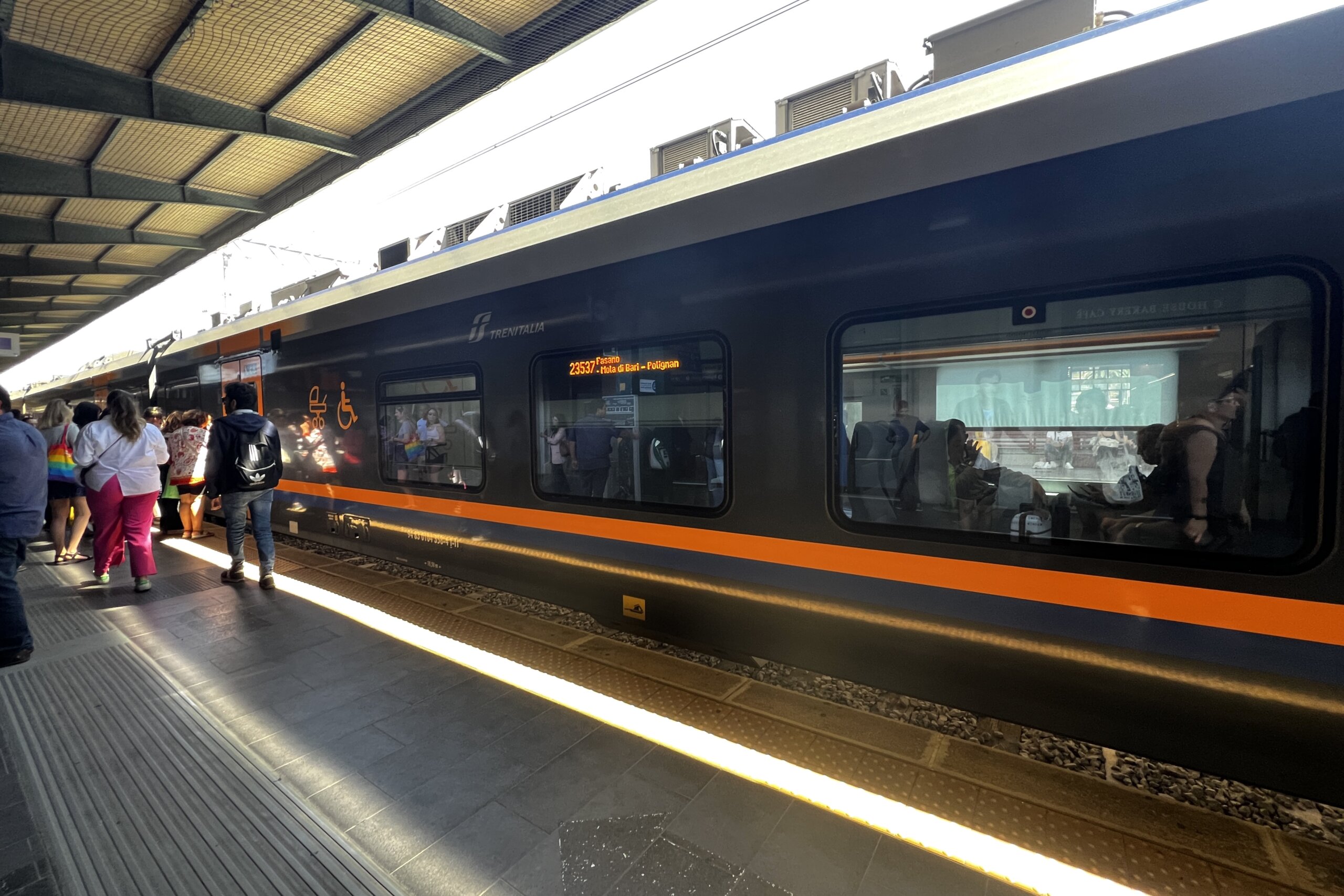
IMPORTANT NOTE: Regional train tickets in Italy are unique in that they need to be validated before you get on the train, so keep that in mind. This is something that catches many tourists off guard and ticket controllers can be pretty ruthless about fines with these.
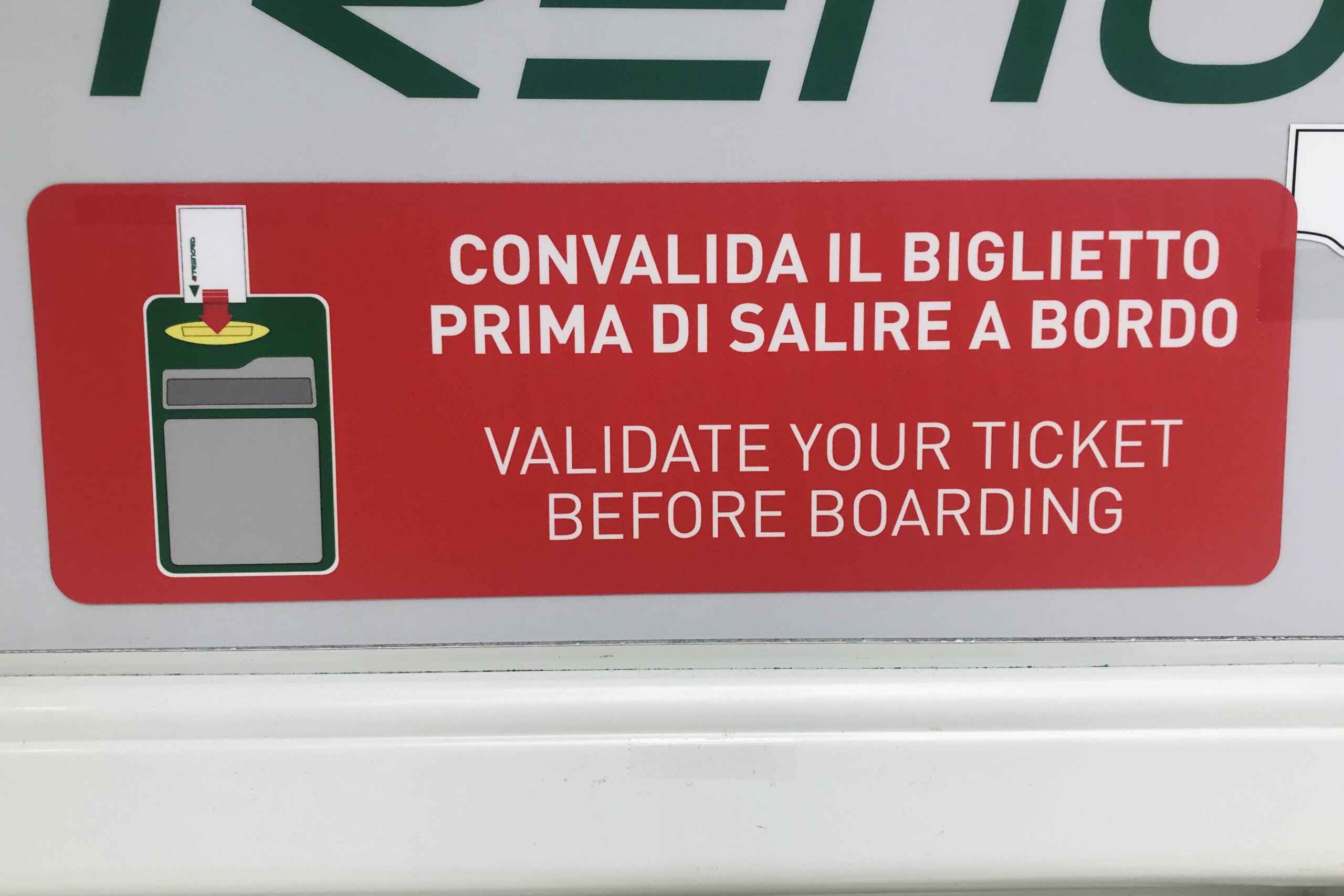
All to say: if you are travelling short distances or prefer flexibility and don’t mind the trade-off of longer journey times and trains with fewer amenities, then using regional trains in Italy is fine. BUT if you don’t mind planning ahead and are prioritizing speed over spontaneity, then often high speed trains only cost a bit more than the regional ones, and can be much better value. In some cases, high speed tickets booked ahead of time will be even cheaper than regional ones!
For example, let’s look at taking the train between Rome and Florence:
- A Frecciarossa train takes only 1h 36 minutes with tickets starting at about 20 euro when booked two months ahead
- An Intercity train connecting the cities is about 13 euro – a few euro cheaper but takes almost double the time, with a journey time of 2h and 50 minutes
- And weirdly, doing this journey by regional train can take up to 4h, and is actually more expensive at its standard rate than a high speed train booked in advance
All this to say, be sure to compare options and don’t just assume that one will be cheaper than the other just because of speed.
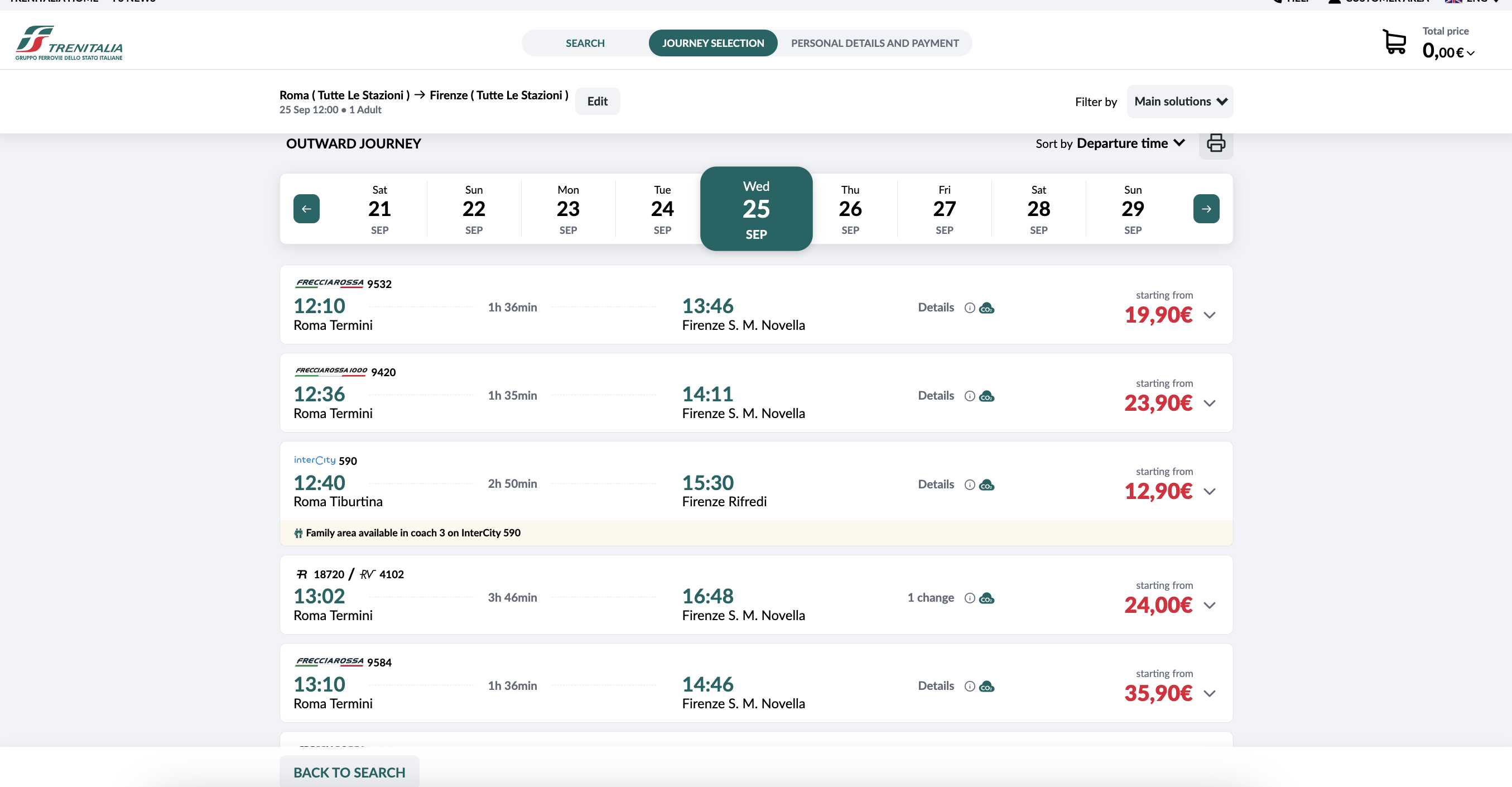
NOTE: Beware the regional trains are meant for shorter journeys and therefore don’t have as much luggage space for large bags as high speed ones.
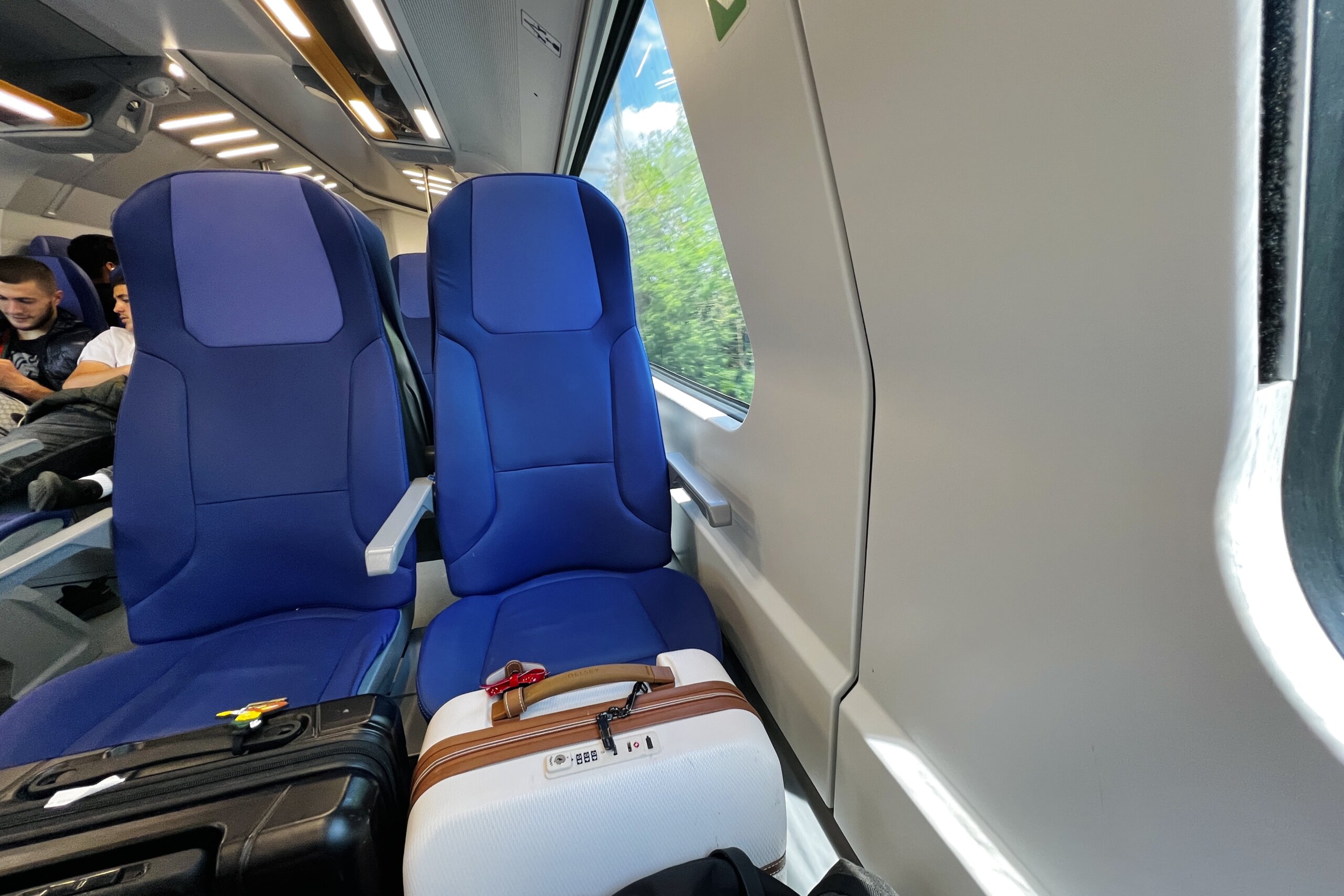
Lastly, on the local train front, we have options like…
- Commuter rail
- And the Metro in larger cities like Milan and Rome
These will have their own ticketing system, so just beware that your train ticket will NOT cover you for onward travel on the Metro to get to your hotel.
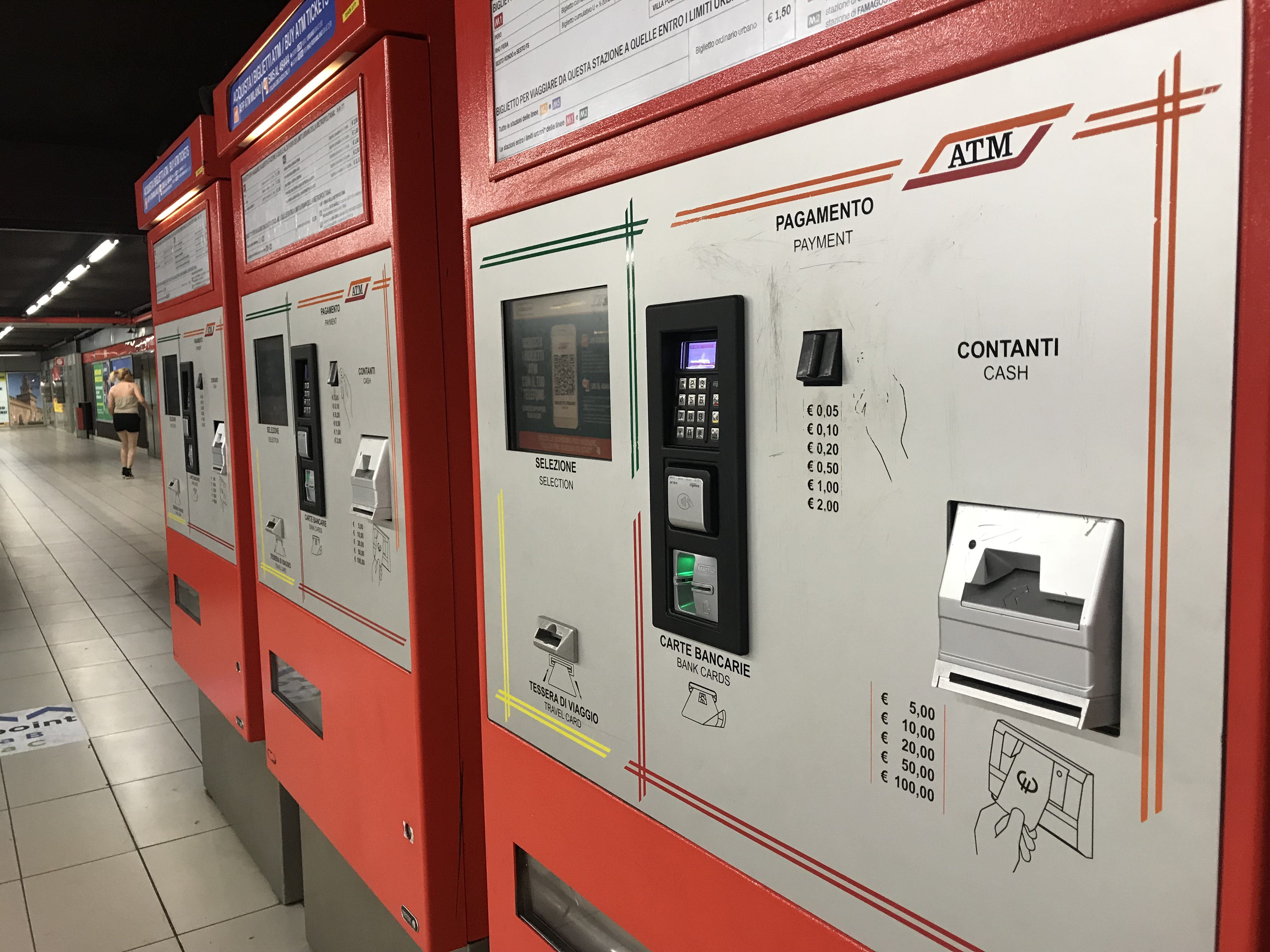
Now that you understand the different types of trains, it’s time to quickly discuss the…
The CartaFRECCIA Program
This is the loyalty program for taking Trenitalia trains.
For the most part, this card is intended for residents of Italy who will be travelling a lot by train, rather than tourists.
BUT a CartaFRECCIA is mandatory if you plan to buy discounted fares like Youth or Senior tickets, or if you want to take advantage of specials like the Carnet ticket packs, which essentially give you a percentage for buying a package of 5, 10 or 15 journeys.
If you feel like you’d want in on these offers, I have good news.
Contrary to popular belief, you do NOT need to be a resident of Italy to get this card. Non-residents can apply for one too by filling out this form and sending to this email: [email protected].
The website says this can take up to 45 business days, but online forum users have shared their experience and many have reported getting it within a few days , so worth trying if you plan to travel a lot by train or want to use one of the discounted ticket programs.
IMPORTANT NOTE: Beware that this program is only valid for Trenitalia though and not Italo.

Now it’s time to tackle an infinitely more confusing topic which is…
Italian Train Ticket Types and Classes
So, to keep things easy, I’ll start off by saying that most regional trains generally only have one ticket type – the Ordinaria ticket, and most only have a standard (second) class. So your options are fairly limited there.
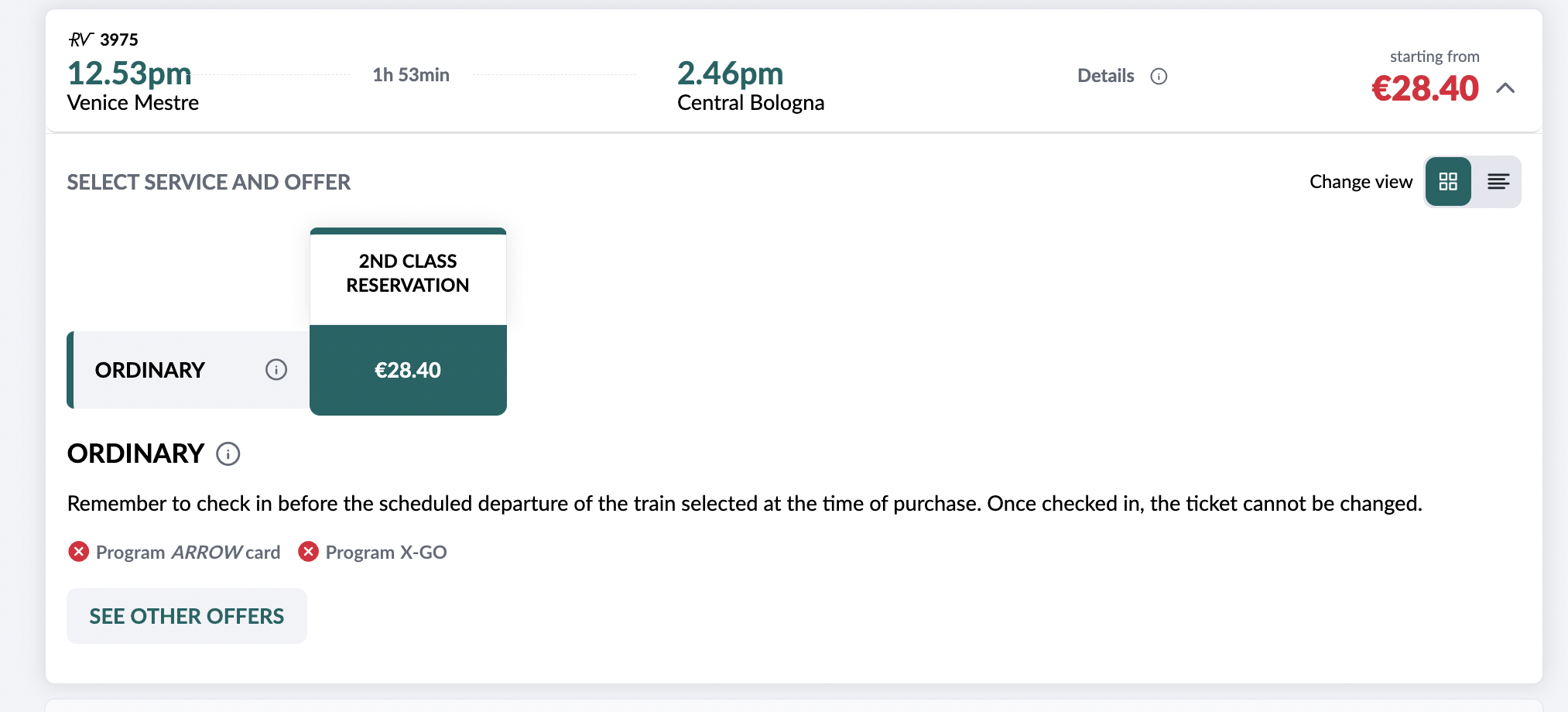
Things get MUCH more confusing however when you start looking at tickets for intercity and high speed trains.
One distinction to make clear when buying these tickets is that it’s not just the fare class that impacts your price, but also the ticket type, which essentially controls how flexible your ticket is, and how much it costs.
This can be very confusing for first timers, but it helps to see it all on a chart. I’ll start with Trenitalia since that’s the more confusing of the two.
When you buy high speed train tickets with Trenitalia, you are presented with a chart that looks like this:
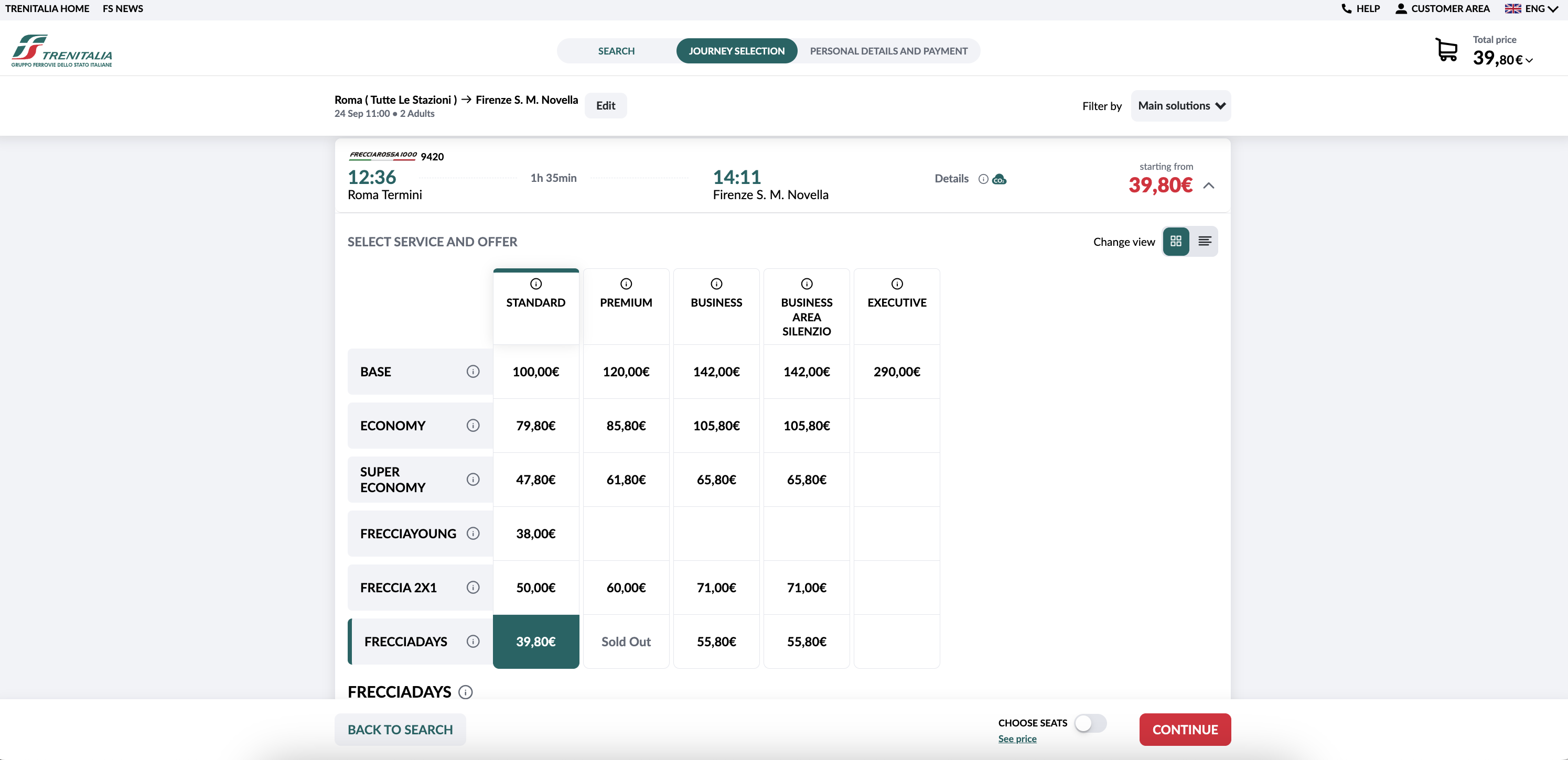
Horizontally, you have the different fare classes. Differences in this will impact where you sit, the type of amenities you get, etc. So like the difference between a standard class ticket vs a business or first class ticket.
Vertically, you have the different fare types, which only impacts how much you pay for your ticket and your eligibility for changes and refunds. This will NOT impact your actual on-train experience or where you sit, etc.
To sum up this difference, someone with a ‘Super Economy’ Standard Class ticket will sit in the same area as someone with a ‘Base’ Standard Class ticket – the main difference is how much they’ve paid for that ticket and how flexible it is in terms of changes and refunds. Be warned: counterintuitively, the Base fare is actually the most flexible one, so don’t get confused by that like I did.
IMPORTANT NOTE: Some fare types are restricted to certain stipulations, like age or number of travellers, so to be eligible for FrecciaYOUNG fares for instance, you need to meet their age requirements and also be part of the CartaFRECCIA program. If you buy a cheaper ticket without meeting these requirements, you may get fined.
Adding further confusion is the fact that ticket types and classes aren’t uniform across companies.
With Italo, you will find a similar chart when you go to book tickets, though luckily there are fewer options.
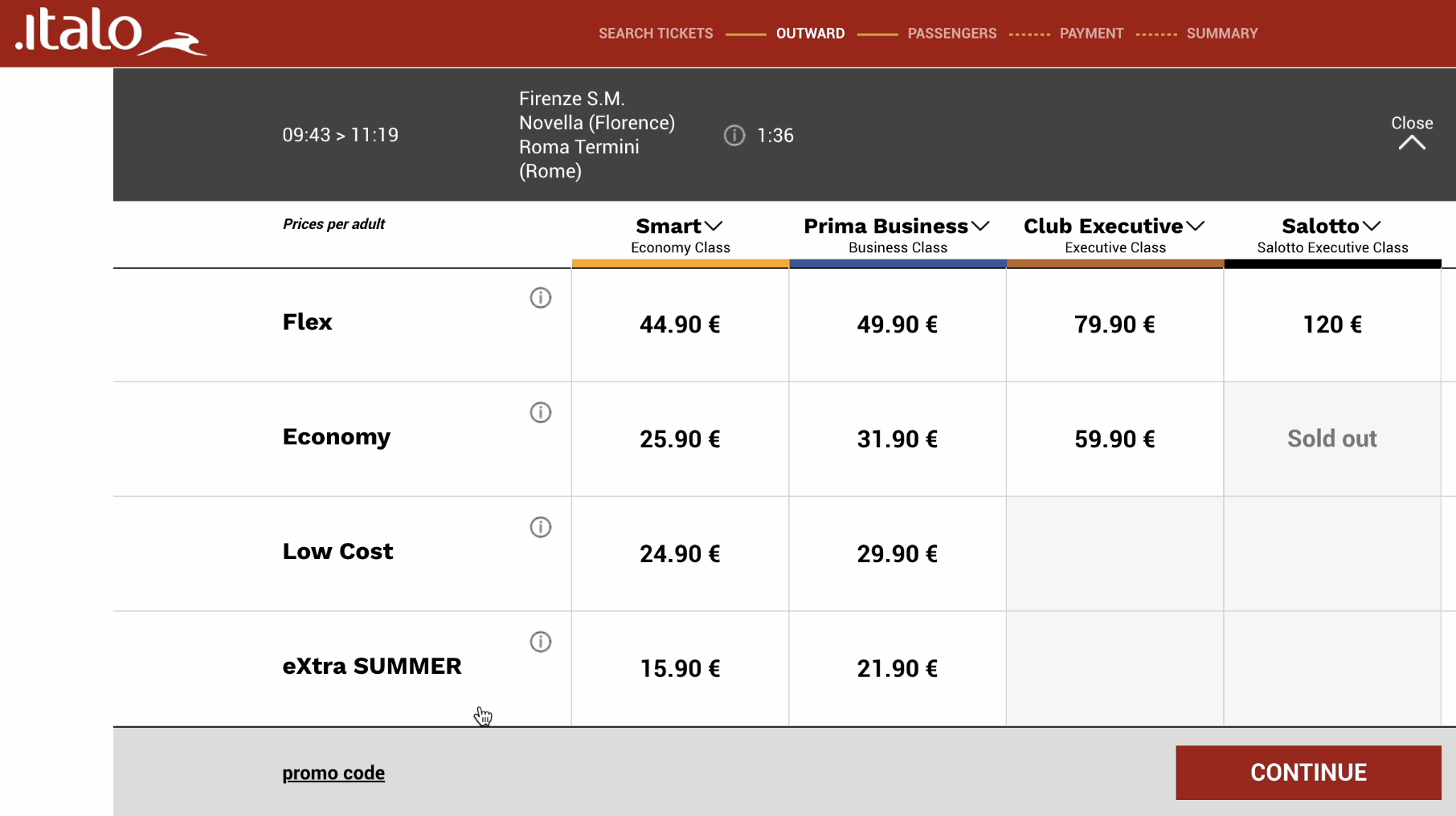
Horizontally on the chart, there are three classes that you can book. Again, this will impact where you sit, the type of amenities you get, etc.
From cheapest to most expensive, they are…
- Smart, which is their standard class
- Prima Business, which has wider and comfier seats, a fast-track boarding option, and a free welcome service with snacks and drinks and…
- Club Executive, which is like the first class option with entertainment screens, on-board catering and lounge access
Vertically, they also have an array of ticket types. Luckily, the names here are much more intuitive...
- Flex, which can be modified for free and refunded
- Economy, which can be modified at a cost, and refunded
- Low Cost, which can be modified at a higher cost, but not refunded
- and this unhinged option just called eXtra SUMMER… which is the bare bones option with no modifications or refunds
In sum, do remember that with Italian train tickets, both the ticket type, usually on the vertical axis of the options table, and the ticket class, usually on the horizontal axis of the options table, do matter.
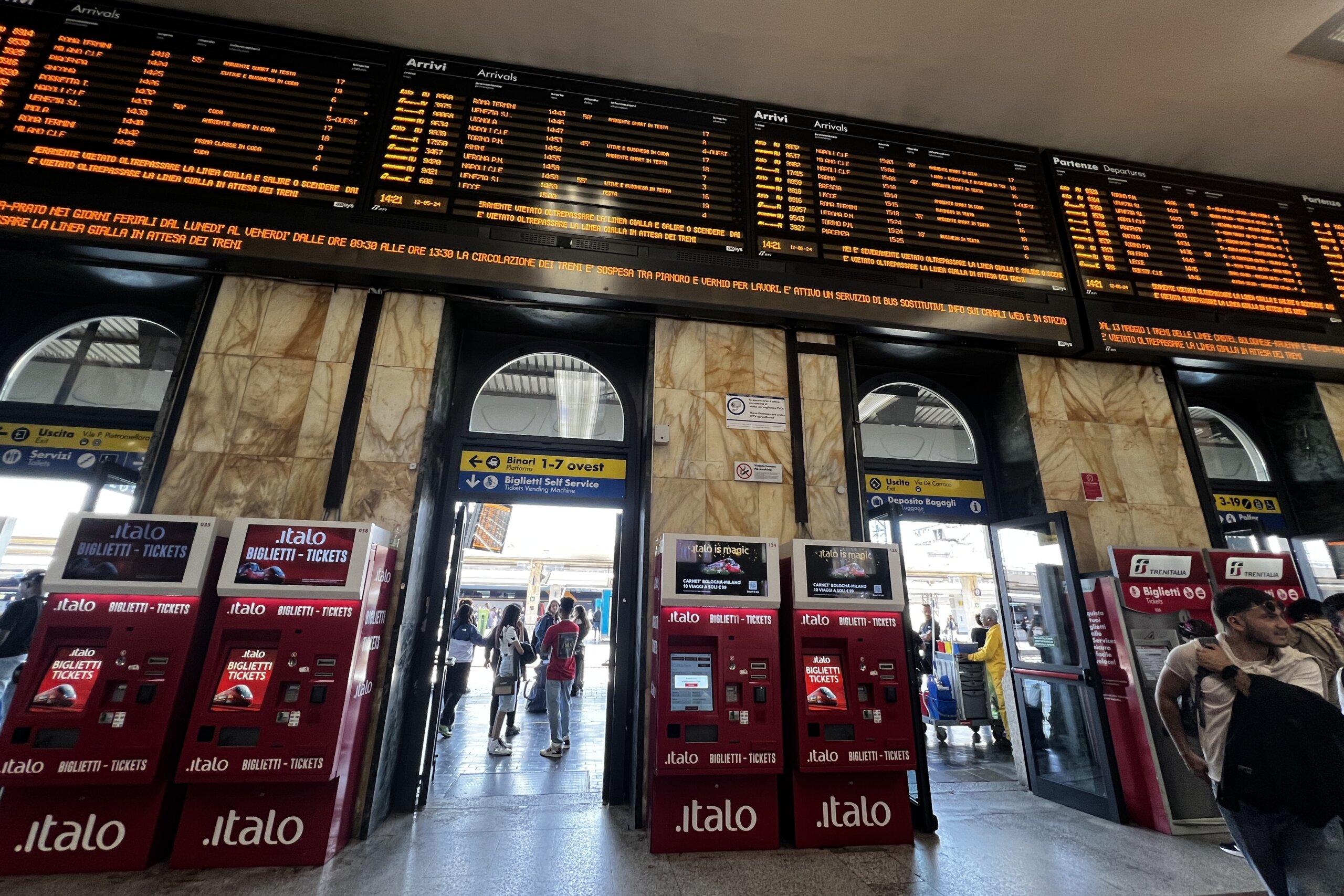
Okay, now with the basics covered, let’s go through step by step how to plan a train trip in Italy, starting with…
Step One: Decide if Train Travel in Italy is Right for You
Now, I do love taking trains in Italy and it has been my go-to over the years, but depending on your priorities I do think it’s important to address alternative options as well that may better suit your preferences.
Overall, I think taking the train in Italy is ideal if you’re…
- Packing light
- Going between major cities that are relatively close together
- Value comfort and scenery
- Want the experience of travelling Italy by train
Luckily, train tickets in Italy are quite affordable compared to other countries like Germany and the UK, especially when you book ahead, so it’s suitable for those on a budget as well!
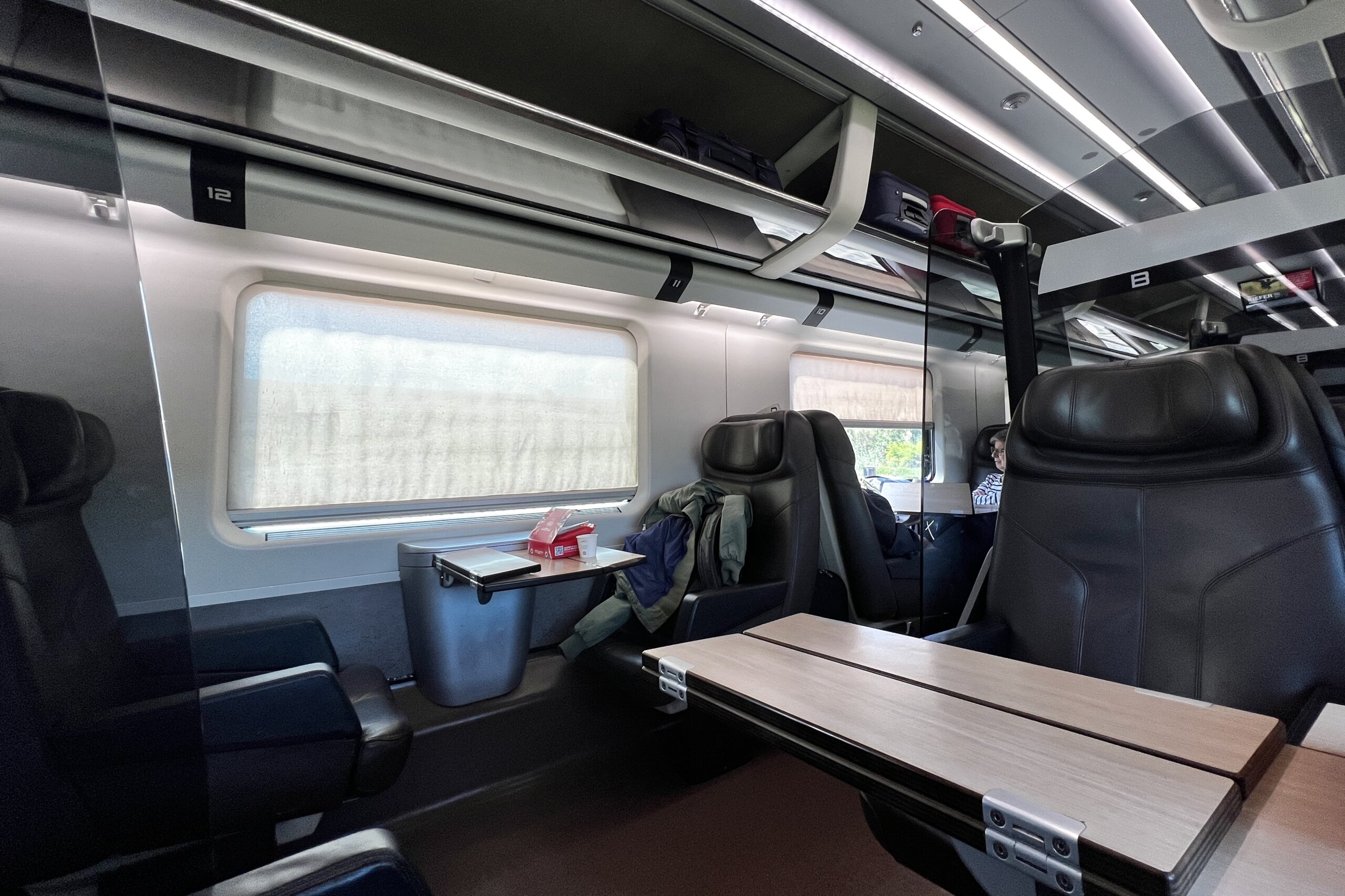
That said, I don’t think trains are well suited to your trip if you’re…
- Travelling with a lot of luggage (more than one big suitcase per person)
- Are covering a large distance (e.g. from the far North to the far South)
- Travelling in an area not particularly well served by public transport
- Prioritizing flexibility and freedom
A more budget-friendly alternative may be taking buses, booking a ride share on services like BlaBlaCar or sometimes even flights if you’re booking with budget airlines like Ryanair, easyJet and Wizz Air.
Or, if your priority is freedom and getting off the beaten path, it may be worthwhile to rent a car.
Overall, if you’re torn and want to compare all your options at a glance, Omio is a great app that shows you planes, trains, and buses from Point A to Point B. From there, you can gauge whether train travel suits your needs.
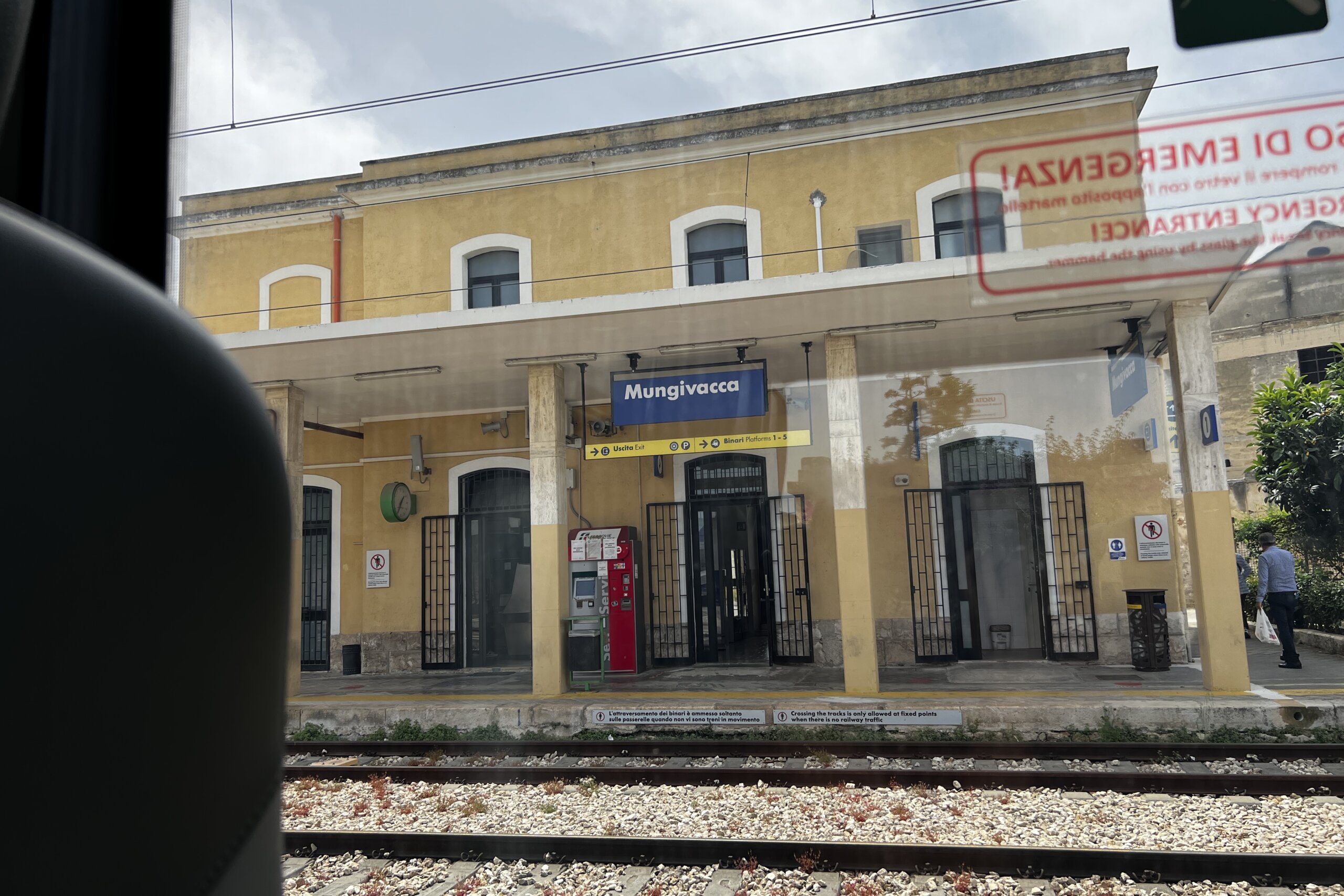
If/when you’ve decided you do indeed want to take the train during your time in Italy, then we move onto…
Step Two: Buy Your Italy Train Tickets
Train tickets in Italy generally need to be purchased and validated before you board the train.
These tickets can be purchased in-person at self-service machines, at ticket offices or, most conveniently online, either through the official operator website (e.g. Trenitalia or Italo) or through a third party like Trainline, Omio or ItaliaRail.
Usually it will be cheapest to book directly through the operator since third parties typically charge a service fee, though there are definitely benefits to booking with a third party.
The main one is you can compare all the options at once. As I mentioned earlier, if you just search on the Trenitalia website of course it won’t show you any Italo trains and vice versa, so it does save a bit of time to use a 3rd party which shows you trains from both companies (as well as buses and flights with Omio).
Another benefit if you’re travelling to multiple countries during your trip, is you can keep all your tickets organized in one place. This is a huge perk for me since I often have many trips booked ahead of time, so the ability to have it all in one place is worth the service fee.
For the best of all worlds though, you could just search and browse through a third party and then ultimately book directly with the operator.
Regardless, whether it’s through the operator or a third party, I always recommend getting a mobile ticket in advance just because the line-ups for these self service machines can often be long, and with mobile tickets you can actually check in/validate them on your phone, which saves you the hassle of validating at a machine.
IMPORTANT REMINDER: With regional tickets, there is no incentive to book ahead of time (apart from sparing yourself some stress at the train station). Prices for regional tickets do not change the earlier you book. The story however is very different with long-distance trains, as booking ahead can often mean huge savings.
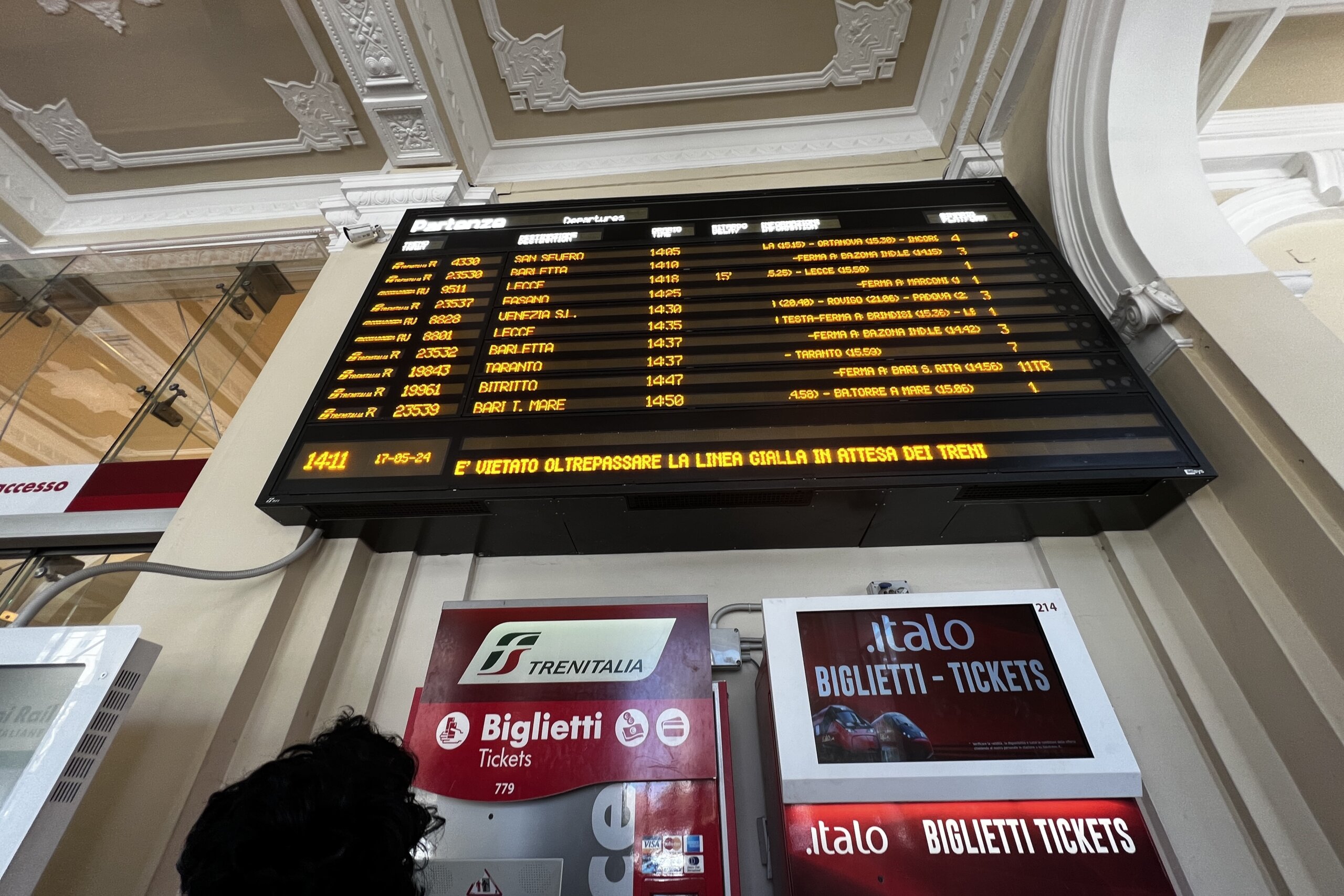
For the sake today’s demo, I’ll mainly be using the Trenitalia website because it shows everything clearer on a big screen, but for purchases on the go, I’d actually recommend using their app or a third party app so you can keep everything on your phone.
So to start, you simply enter your departure point and destination. Remember that even the English versions of these sites will usually use the Italian names of destinations, so put Roma instead of Rome, Firenze, instead of Florence, etc. otherwise it may not work.
Now it’s important to note that many large cities have multiple train stations so when you are choosing your departure or destination, you’ll have to specify which train station in particular you mean. Alternatively, you can look out for the term Tutte Le Stazioni – which means All Stations. When you select this, you’ll be shown options from all the possible stations in that city.

From here you can also toggle on a few different options, for instance if you only want to see Frecce High Speed, Intercity or Regional trains, whether you want a single one-way ticket or a return, as well as desired date and number of passengers. Be sure to put this in as Trenitalia often has special offers for multiple people travelling together.

You will then be shown a list of all the options, bearing in mind the default is of course the 24h clock, so it’ll say 13:02 instead of 1:02pm, etc.
So on this next screen, you can look at all the options. The default sorting is by Departure time but you can also sort it based on Arrival Time, Journey Time and Price.
Again, on the left column you can easily identify whether that train is a high speed one, an Intercity one, or a regional one by looking at the little logo and train number above the time.

When you see a train you like you can click this down arrow to pull up the options, at which point you’ll probably see a similar chart to the one I showed you before. Again, remember that the vertical options are for the ticket type which controls price and flexibility, while the horizontal options are for the train class which will impact what train carriage you’re in and what amenities you get.
If you’re traveling as a pair, one really great deal to look for is the Freccia 2×1 which in explicably gives you two tickets for the price of one. These tend to sell out very quickly so you may find yourself in a situation where a 2×1 business class ticket is acctually cheaper than a regular price standard class ticket, so a great way to justify treating yourself.
If you want to select your own seats usually for a fee, then you can toggle this bit in the bottom right hand corner and it’ll take you to seat selection.
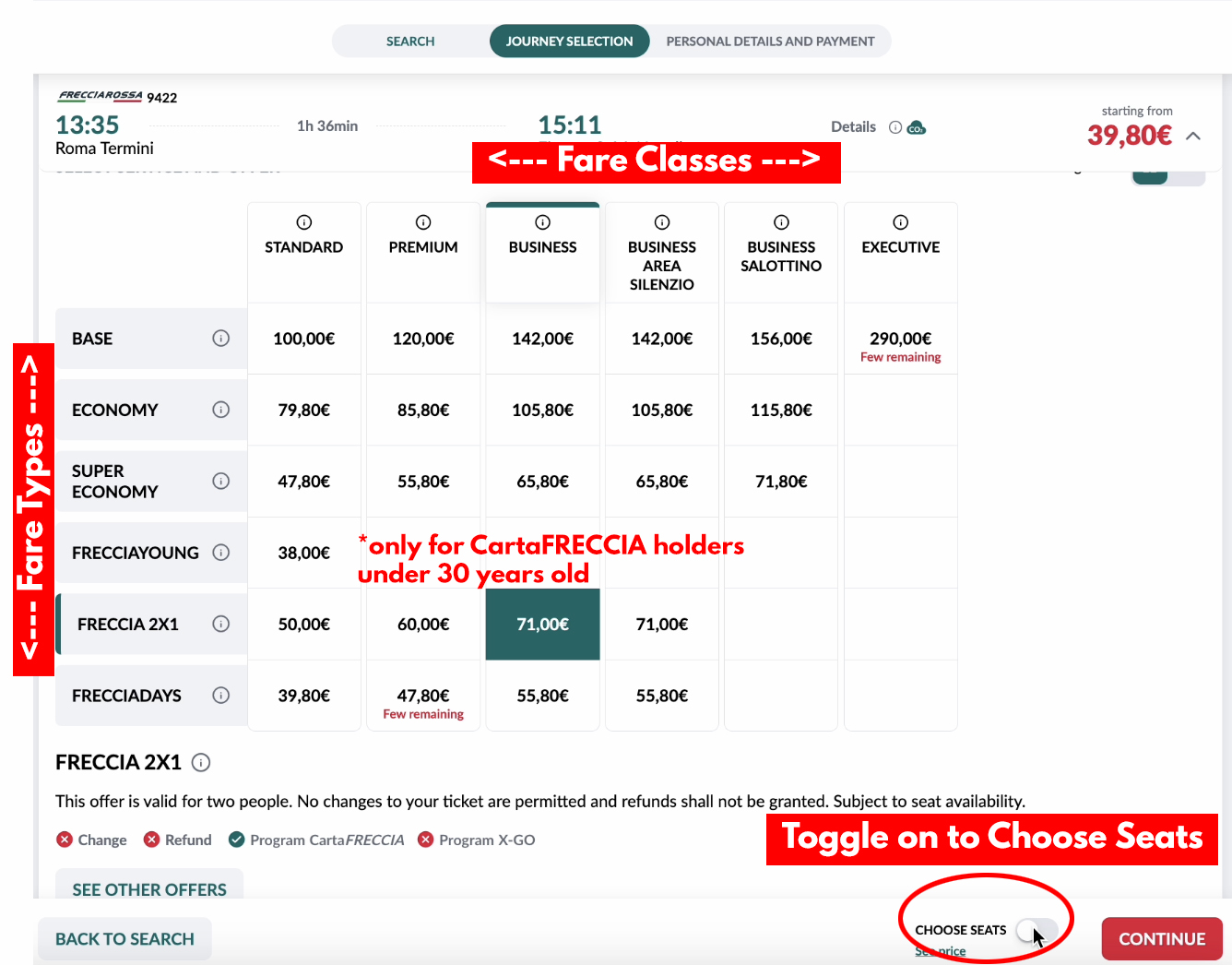
In this screen, pay close attention to the direction that the seats are facing. It is very common on Italian trains to have seats facing each other so even if you book a single seat, depending on which one you pick you might awkwardly end up facing someone and sharing a table for the entire 6 hour journey.
Beware that seat reservations usually aren’t possible on regional trains, however seats are assigned for pretty much all high speed trains. You’re usually assigned one at random, but you can also choose your own if you want the flexibility. Depending on the ticket you book, choosing a seat may cost a bit extra.
Once you’re happy with your seat you can click continue and then you can finish the transaction by adding your details and payment info.
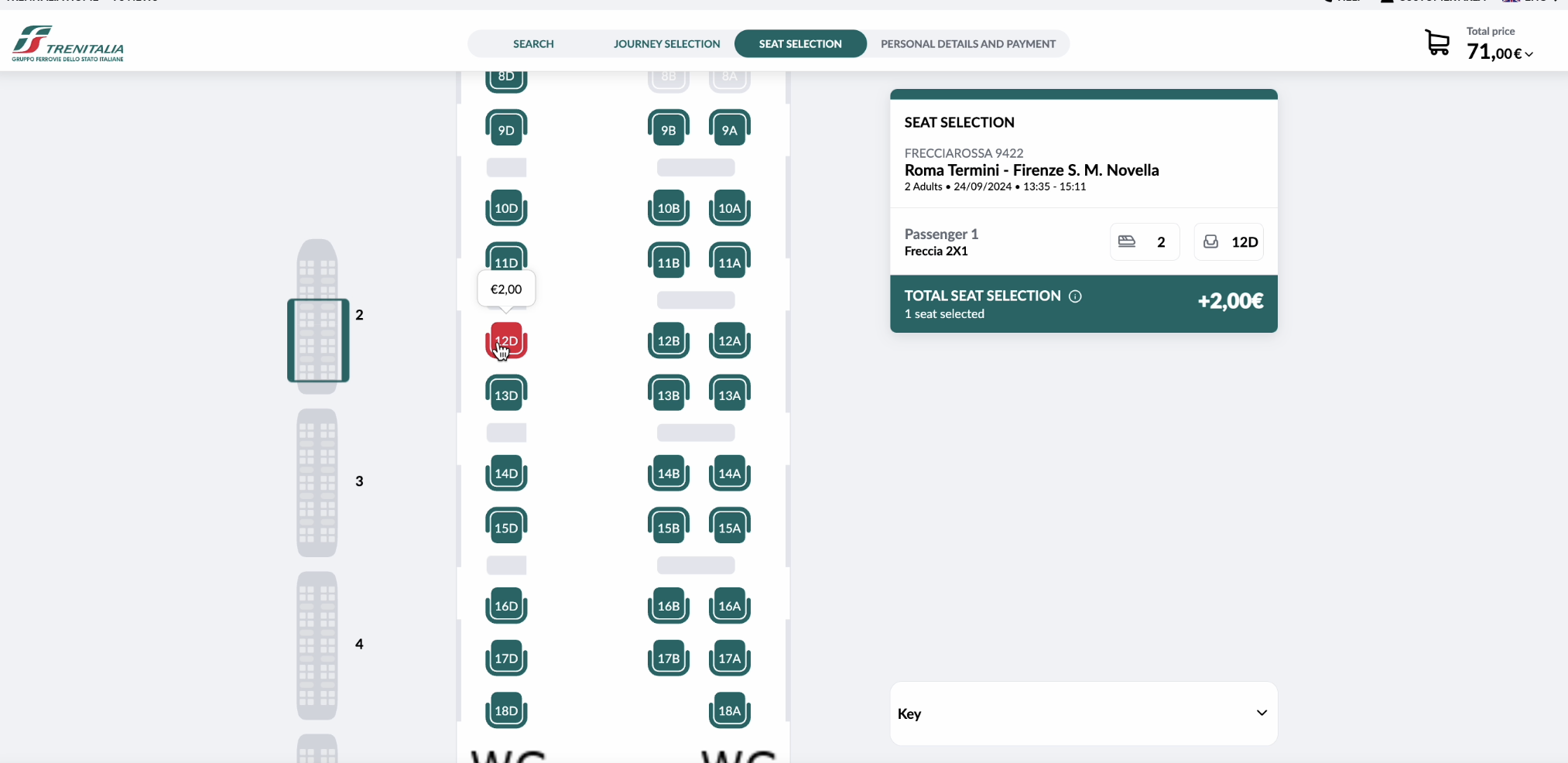
Now, this of course was the process to follow for standard point to point tickets, but there are also some passes you can get that will work differently.
So let’s move onto a discussion of…
Standard Tickets vs Rail Passes
Honestly, in most cases, buying individual tickets in advance is going to be the cheapest option for trains if you’re not doing many journeys.
If however you plan to take the train a lot, it may be worth looking into some passes that could save you money or offer other perks like enabling spontaneity.
With Trenitalia for instance, they have special offers like…
- The Italia in Tour promotion which allows you to take unlimited regional trains for 3 days or 5 days
- And the Trenitalia Pass which can save you money by purchasing a number of high speed trips in a set time period, all for one package price
Italo also has Travel Packs that are similar for their trains.
Of course, if you plan to mix both regional trains and high speed trains from across companies, and possibly will be travelling to other countries in Europe as well, then it’s worth looking into a Eurail/Interrail Pass which allows you take unlimited journeys for a set number of travel days.
If that interests you, I have a full Eurail Pass review you can check out.. but do beware that paid seat reservations are mandatory for Eurail and Interrail pass holders for high speed trains, which can often drive up the cost quite a bit.
All to say, for the average visitor, just buying point to point tickets usually makes the most sense, but do look into these additional offers if you think they’d be the right fit for you.
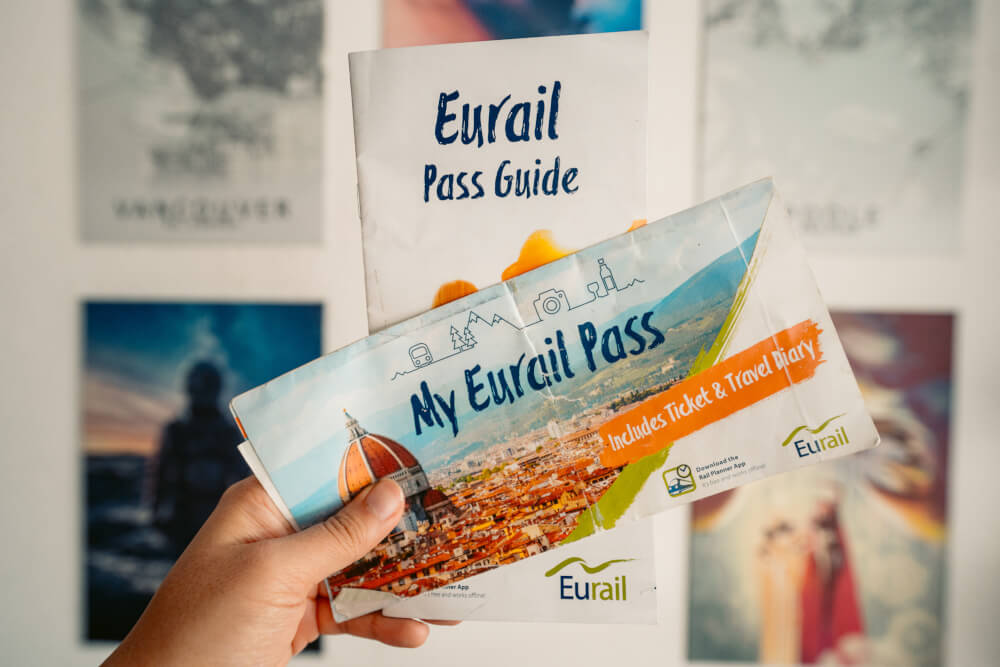
Okay, that was a long discussion but assuming you have now secured your tickets, we are now ready to move onto…
Step Three: Get Snacks for the Journey and Use the Facilities
Before you get to the station for you big train trip, I highly recommend you grab some food and drink to bring with you on the train (especially for longer trips), especially if it’s a regional train as no food or drink is sold on board these ones.
And while there are usually some food options on board with high speed trains, they tend to be fairly limited and pricey, so getting your own is usually a good idea.
At the very least, get some water or something to drink. Depending on the station, there may be options available there, especially in bigger cities, but I find the line-ups to sometimes be super long.
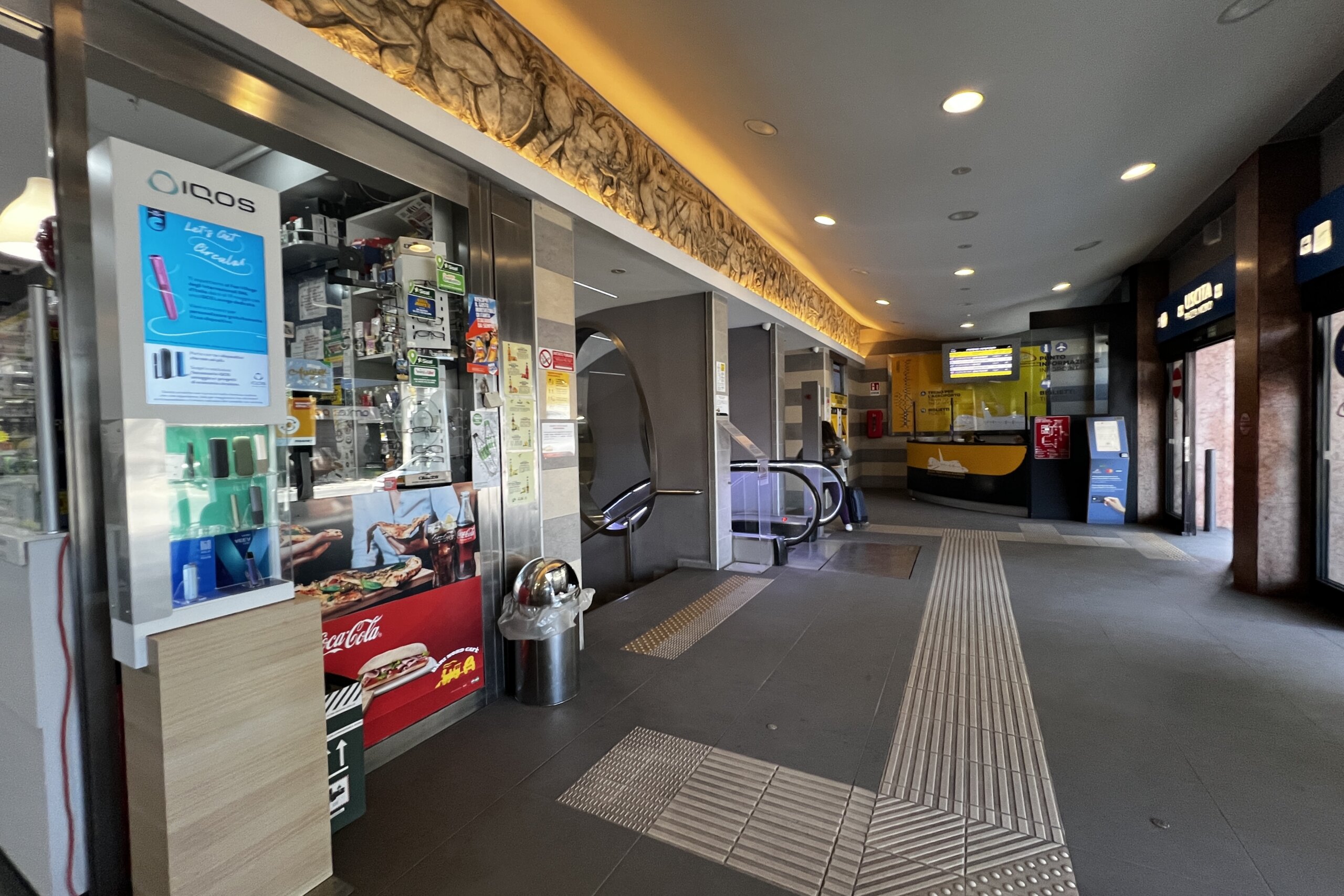
And don’t forget to take care of business bathroom-wise before you go! You need to pay to use toilets at Italian train stations, and cleanliness/toilet type vary, with some stations having squat toilets!
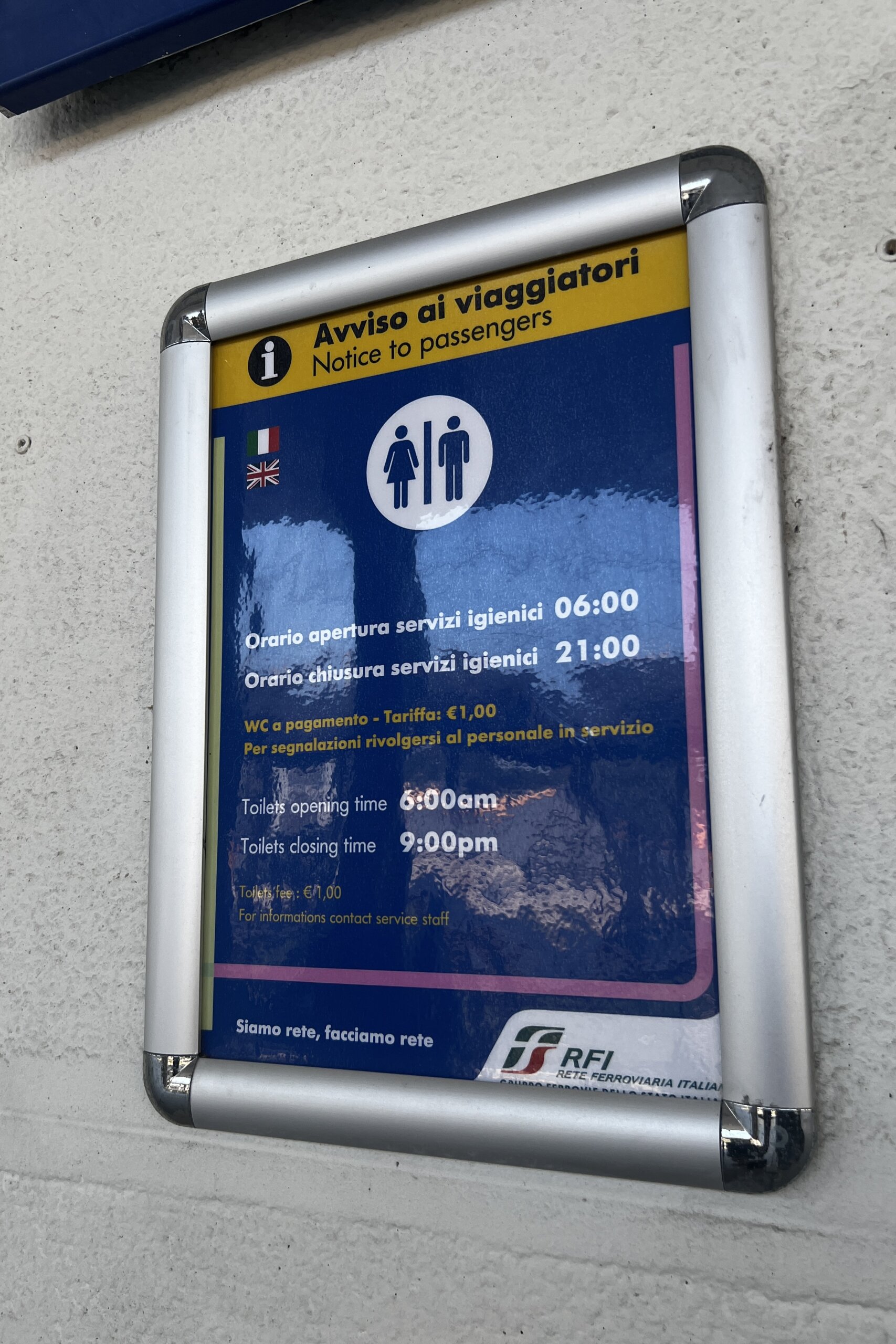
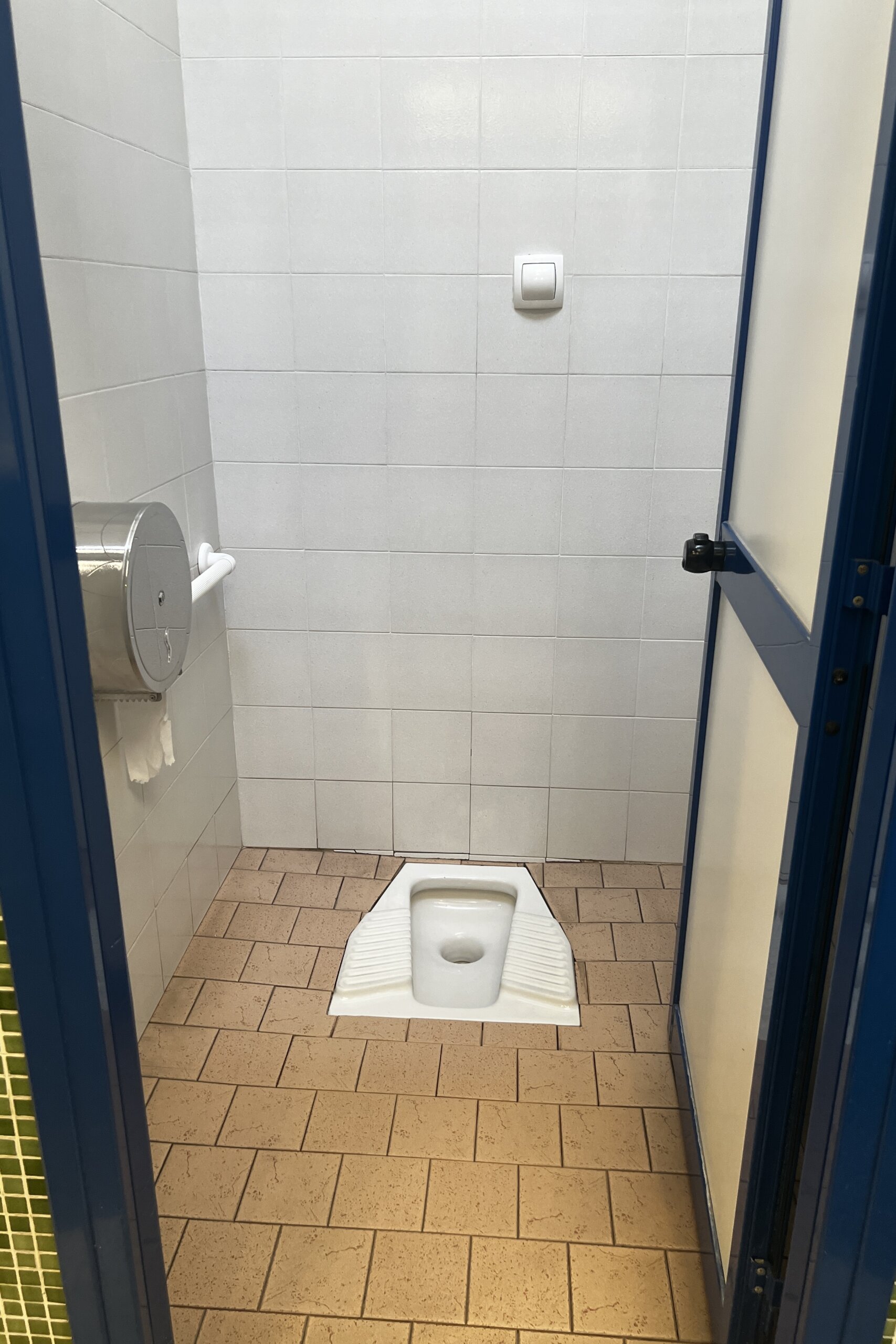
Now, let’s move onto…
Step Four: Arrive at the Station
If you’re new to train travel in Italy, I’d definitely recommend arriving to the station about 20-30 minutes before your scheduled departure, or longer if you need to get tickets in person, as stations especially big ones can be tough to navigate.
Again, do remember that some cities have multiple stations so before you get ready to leave, double check the station name and make sure you go to the right one.
I find that most Italian train stations have really good signage, so if you find yourself in a transport hub for instance that has multiple modes of transport, look for the word “TRENI” which means Trains or a train symbol, and that should point you in the right direction.
If you still need to buy tickets, look for signs that say BIGLIETTI or BIGLETTERIA which will point towards ticket machines and or the ticket office. Remember it’s always better to get your tickets ahead of time though to minimize stress!

Now, once you’re at the station, assuming you have tickets, your first order of business is finding out which platform your train will be on.
The most reliable place for this information is on the train station’s Departures board, usually marked with the word Partenze. There’s typically a large one in the station’s main area, and smaller screens as well scattered around.
From the left to right, the board will usually say…
- TRENO which specifies the train company, type and number
- DESTINAZIONE which is the final destination of the train
- ORARIO which is the time of arrival
- RITARDO which is the amount of delay
- BINARIO which is the platform
NOTE: Depending on the size of the screen, these may be shortened so RIT or BIN instead of Ritardo and Binario.
Some screens might also have a column for INFORMAZIONE which is extra information like closures, reasons for delay or sometimes extra details like where the First Class carriage is situated.

Now, when looking at the board, be on the lookout first and foremost for the train that matches your train number and departure time. Do not just go looking for the name of your destination, because the boards usually list out the final destination, so you might not see yours right away.
And just a a reminder, usually destinations are given in their Italian name, so be sure to know the Italian names of your destinations (e.g. Venezia instead of Venice, Firenze instead of Florence).
When you’ve located a match for your train, you can take a look at the right side of the board in the Binario column. The number here will tell you which platform the train is on. Sometimes one won’t be shown. This means the platform is not yet known, so you just have to wait tight for it to update. Don’t stress too much about this – everyone else on your train will be doing the exact same thing!
When in doubt, at larger stations you may find dedicated customer service personnel for both Trenitalia and Italo where applicable – they’re usually clearly identified with a branded vest or jacket so keep an eye out. From experience, they’re actually quite helpful most of the time.
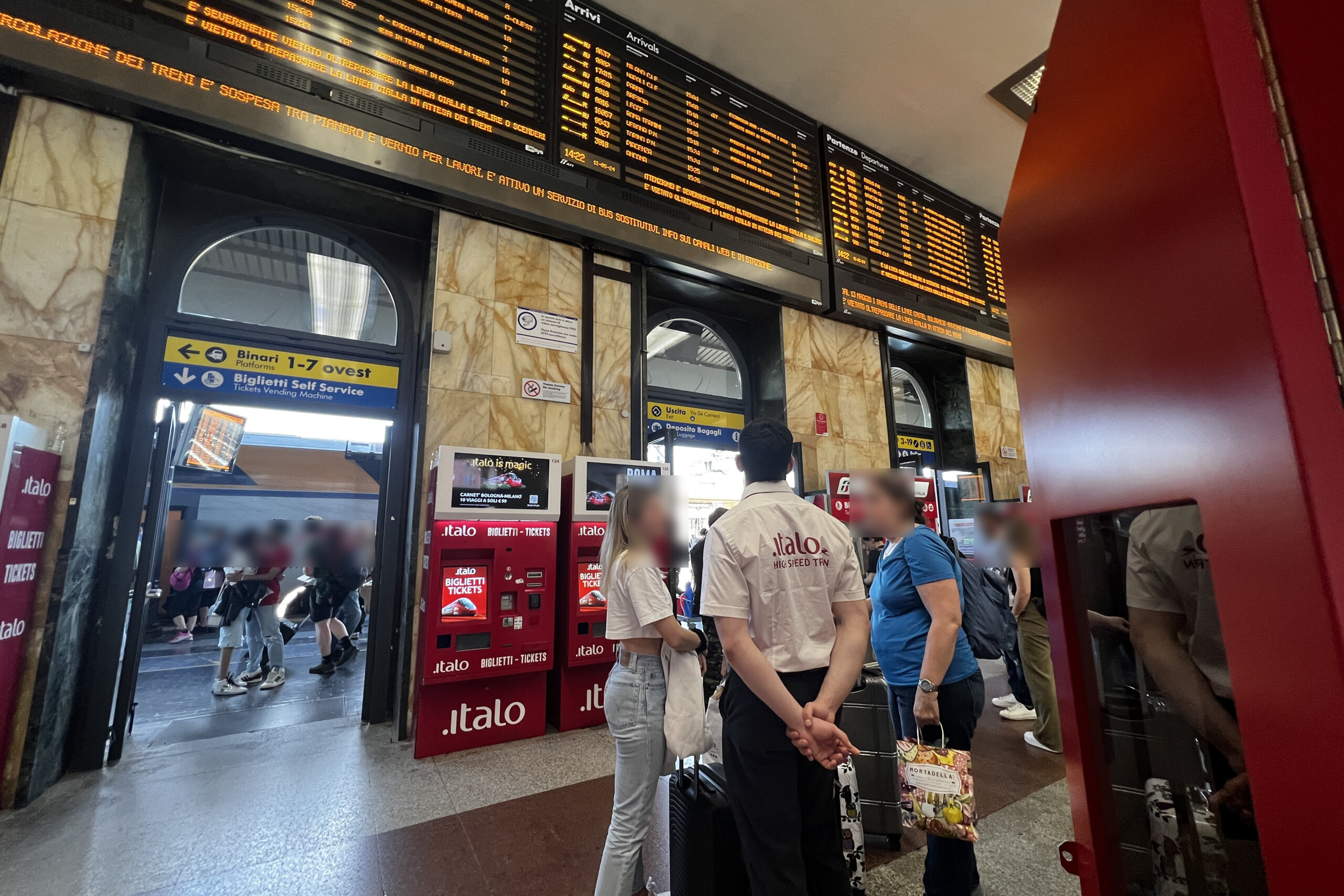
You can also get real time info for your train here.
NOTE: Be careful with your valuables while at train stations especially when you’re distracted like when you’re reading the departures board – sadly train stations can often be a hot zone for pickpockets and thieves. Check out my guide to avoiding pickpockets for more info.
With the platform number secured, next is…
Step Five: Get to the Platform
Platform numbers will generally be very well marked so just look up for signs that point in the direction of your platform number. Now do beware though that you will often need to make use of an underground walkway, AKA Sottopassagio to get to other platforms.
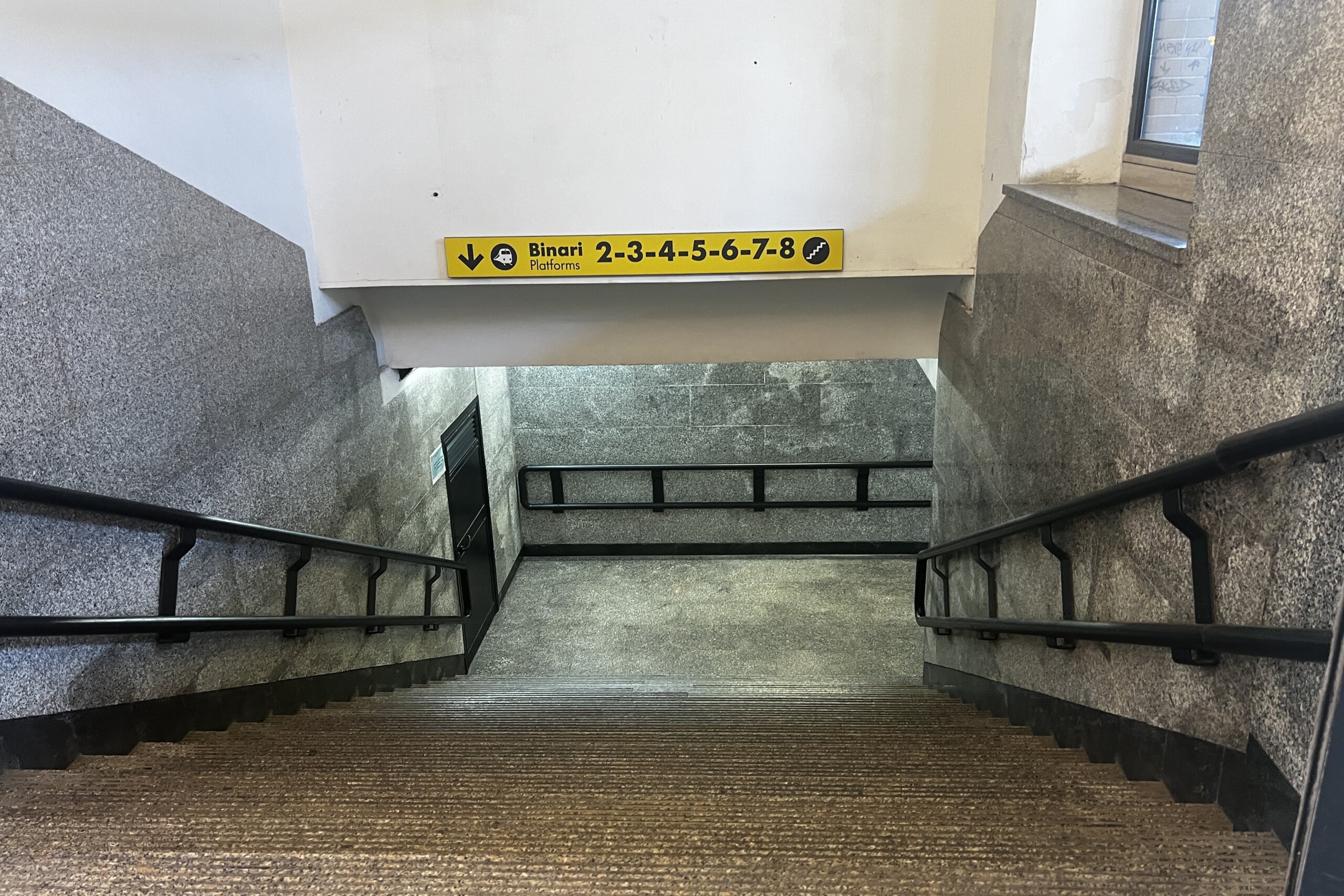
Where there aren’t walkways available, especially at smaller stations where the tracks are on the same level as the platform, you can walk across after making sure no trains are coming.

Now as a reminder, you do need to validate your ticket for a regional train, so if you have a paper ticket keep an eye out for these machines:

Or if you have an online ticket don’t forget to validate the ticket by ‘checking in’ online.
At larger stations there may be fare gates where you need to scan your ticket to access the platform, so be sure to have your ticket handy. Most stations will not have this though and you’ll be able to walk straight over.
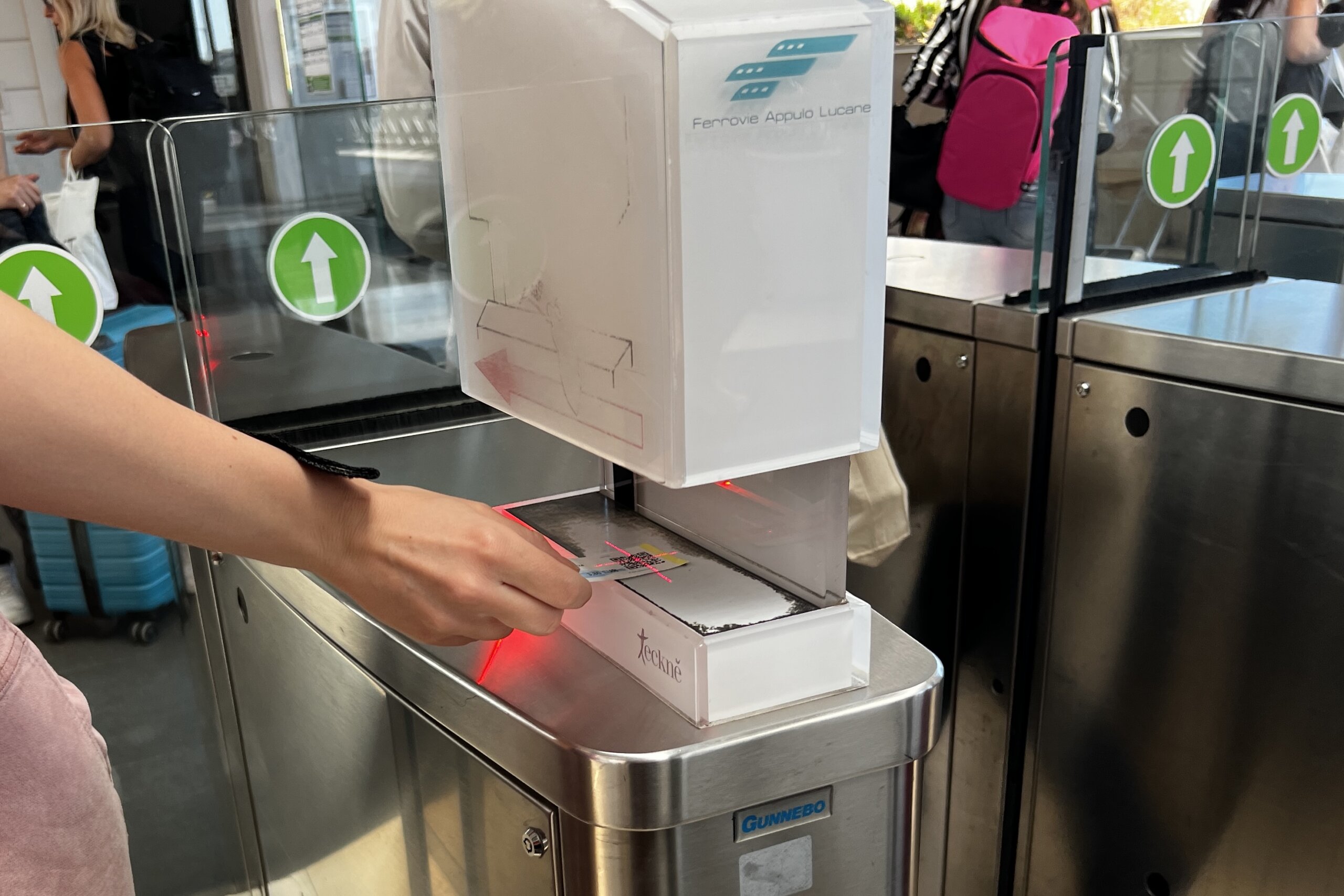
When you get onto your platform, double check it’s correct by confirming either on a platform screen or on the side of the train that you’re in the right place before proceeding to find your carriage.
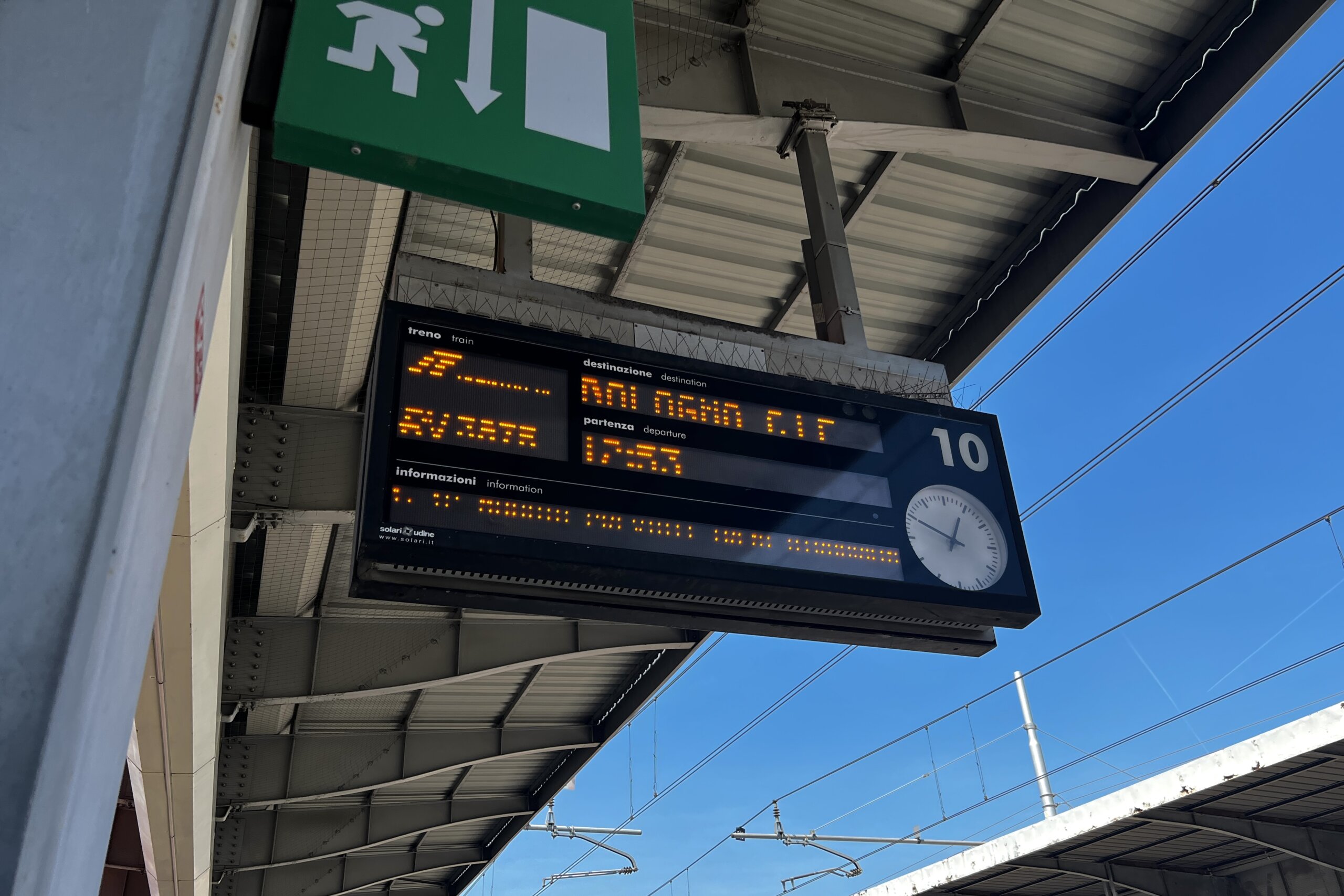
Step Six: Find Your Carriage
Now, if you have a reserved seat, which you will if you are on a high speed train, then you’ll need to take some extra steps to make sure you get to the correct carriage once the train arrives.
On your ticket, there will be two critical pieces of info – the carriage number and the seat number.
Italian high speed trains can be quite long, so keep an eye out for numbers on carriages as they arrive. On or around each carriage door as well, they will usually write out which seat numbers can be found on that side, so to avoid awkward shuffling through the carriage, be sure to pay attention to that too.
If you do not have an assigned seat, then you simply need to board a carriage in the right class, then pick a free seat. If you don’t have a reserved seat, then usually I find the farther you walk, the emptier the carriages will be.
Once you find or choose your carriage, then it’s time to hop on board!
If the door isn’t opening then look for a button like this <> and press it. This goes for the train doors as well as carriage doors.
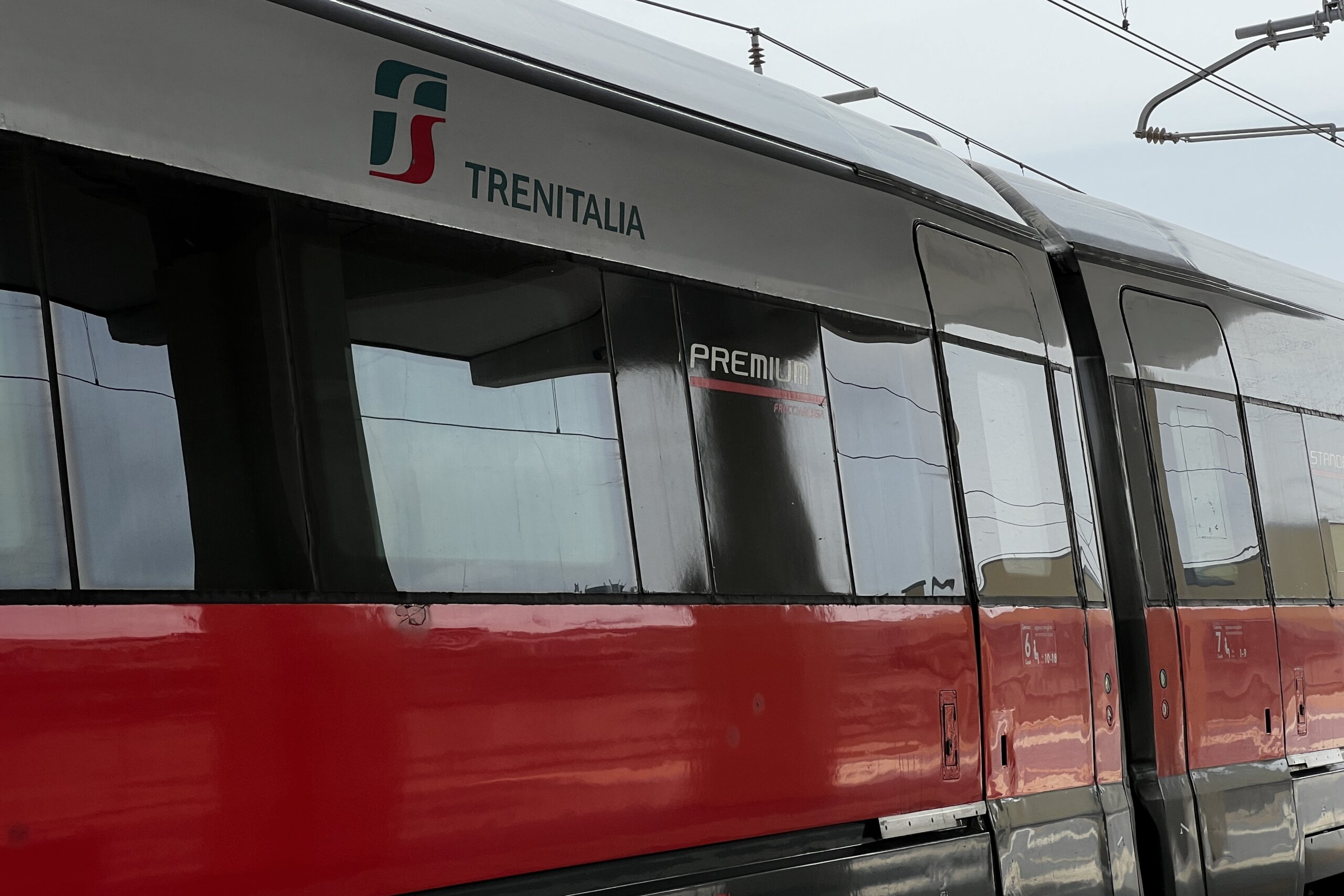
Now for the next step…
Step Seven: Find Your Seat
Again, if your seat is assigned, try to make sure you go in through the correct door closest to your seat.
High speed trains will usually write the seat numbers on the corresponding door, like so:
If you have large suitcases, be sure to drop them in a luggage rack before you take a seat. Ideally it should be a rack close to your seat, even visible from your seat if you can. For high speed trains they will sometimes have luggage racks on the ends of each carriage, as well as one in the middle but this depends on the train.
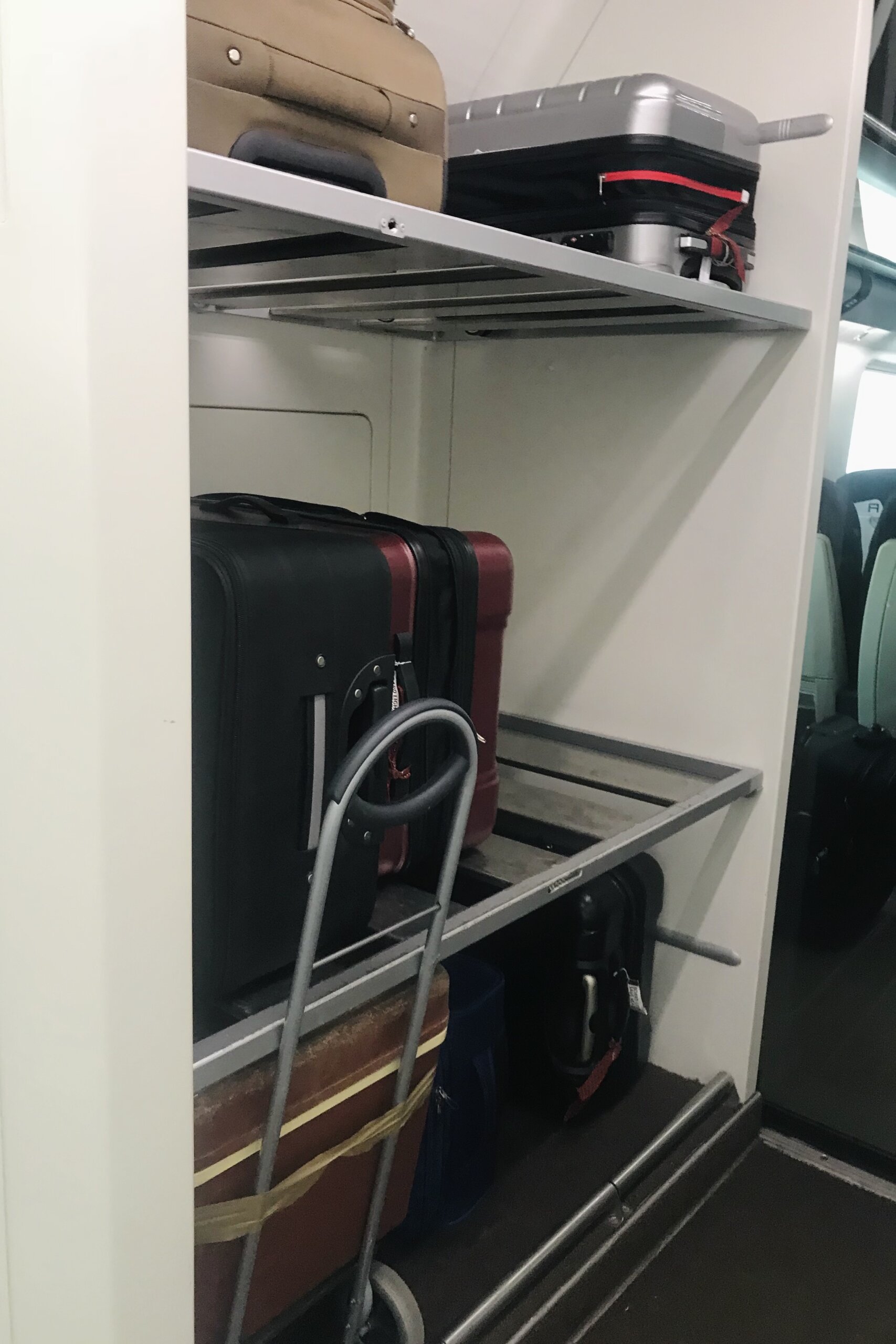
In any case, look out for a suitcase symbol as this will point to where you can stow luggage. On some regional trains for instance they have space under the seats for luggage.

Then simply make sure you’re in the right carriage (the number will usually be written above the doors) and the right seat, then make yourself comfy!
That brings us to…
Step Eight: Get Comfortable and Enjoy the Journey!
Once you’re all settled, you’re now in a good place to enjoy some of the hidden features and amenities of your train.
Okay, I say “hidden”, but what I mean is they’re easy to miss, especially if it’s your first time on board an Italian train.
So, be on the look out for…
Coat hooks: These can be found on the wall next to your seat – sometimes they may need to be pulled out. You can leave coats, scarves, etc. on those
Plugs: Most trains will have an area to charge electronics, often on the wall or under your seat.
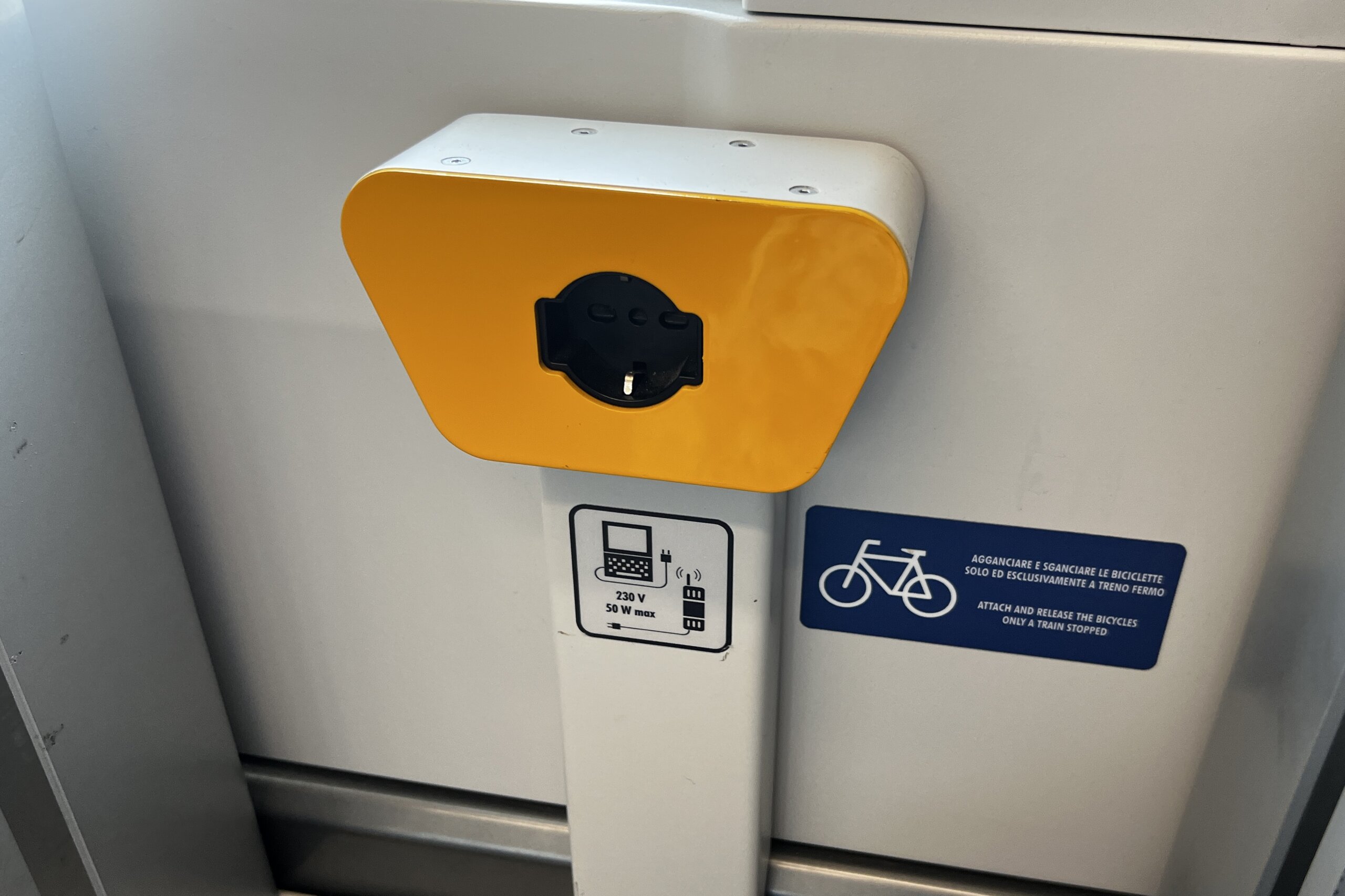
WiFi: Most high speed trains will say they have this but the quality is questionable depending on where you are.
On-board restaurant or bistro: You’ll find these on high speed trains.
Bathrooms: And of course, don’t forget to look for the on-board bathrooms (which are free). They’re typically marked by signs saying “WC”..
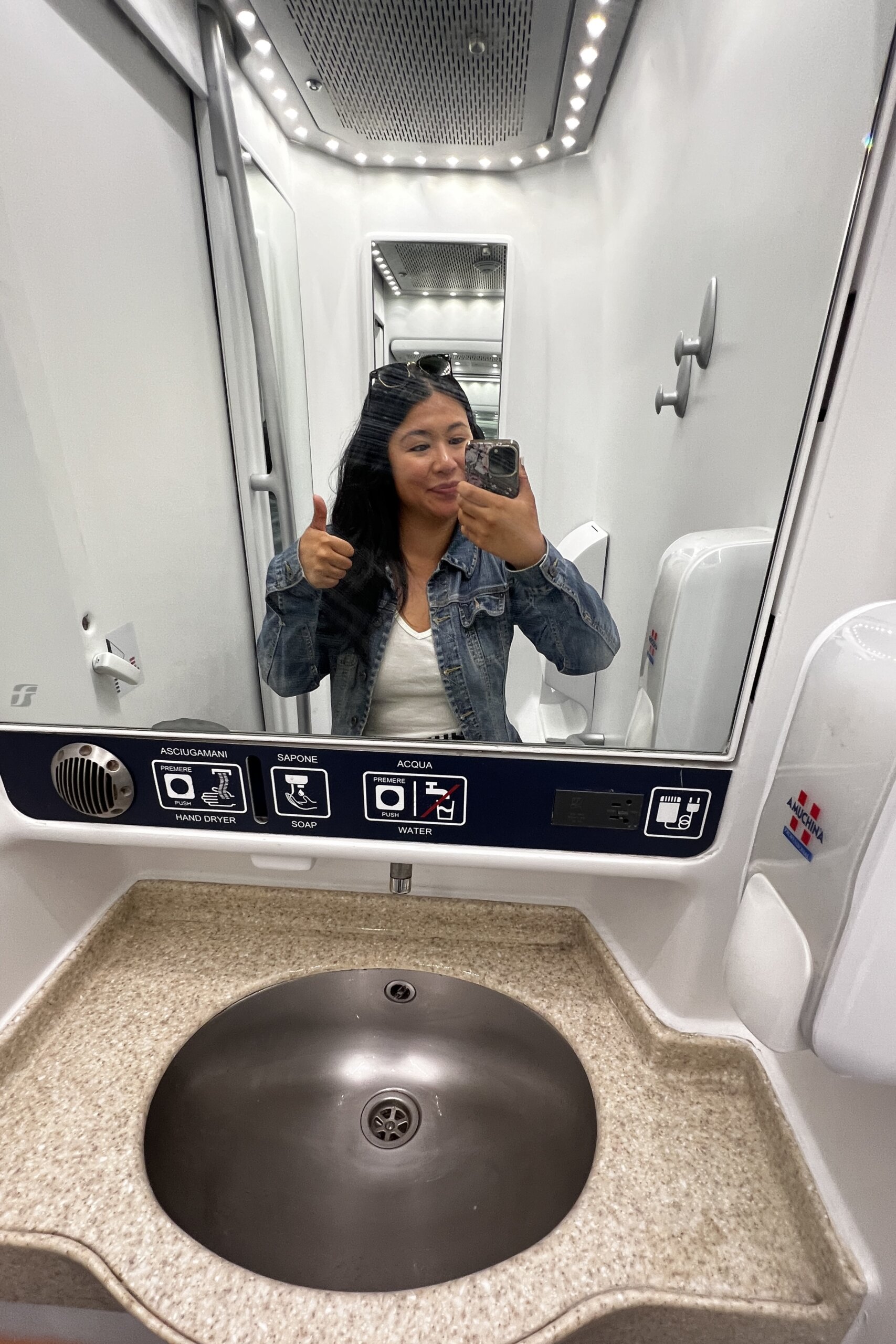
Now, as you get comfy, keep your ticket and ID handy in case controllers come on board. Checks aren’t as common on regional trains, but are almost guaranteed on high speed ones.
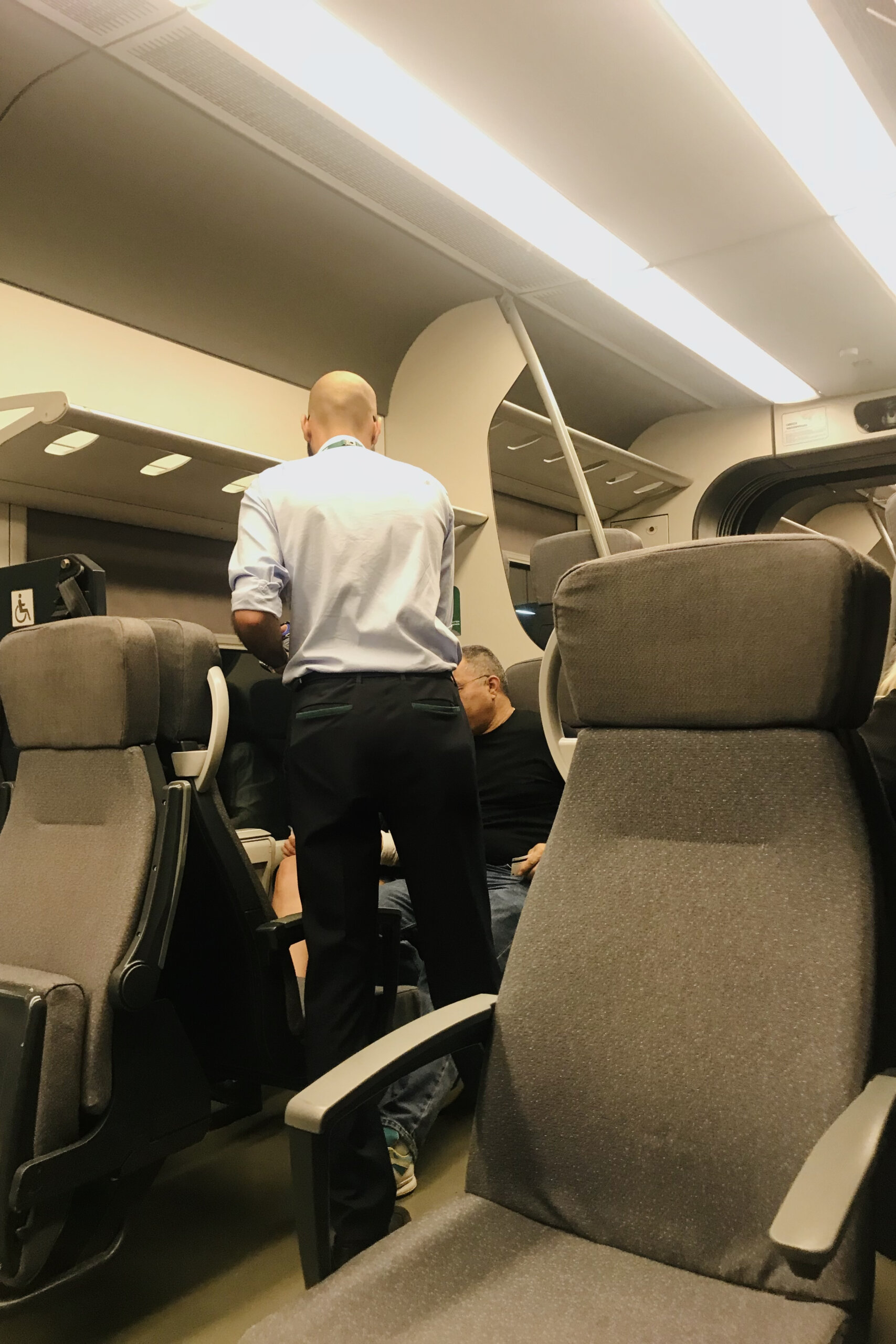
NOTE: Be careful with what you put on the tables as sometimes the trains come to a somewhat abrupt stop and things can slide down e.g. cups and water bottles.
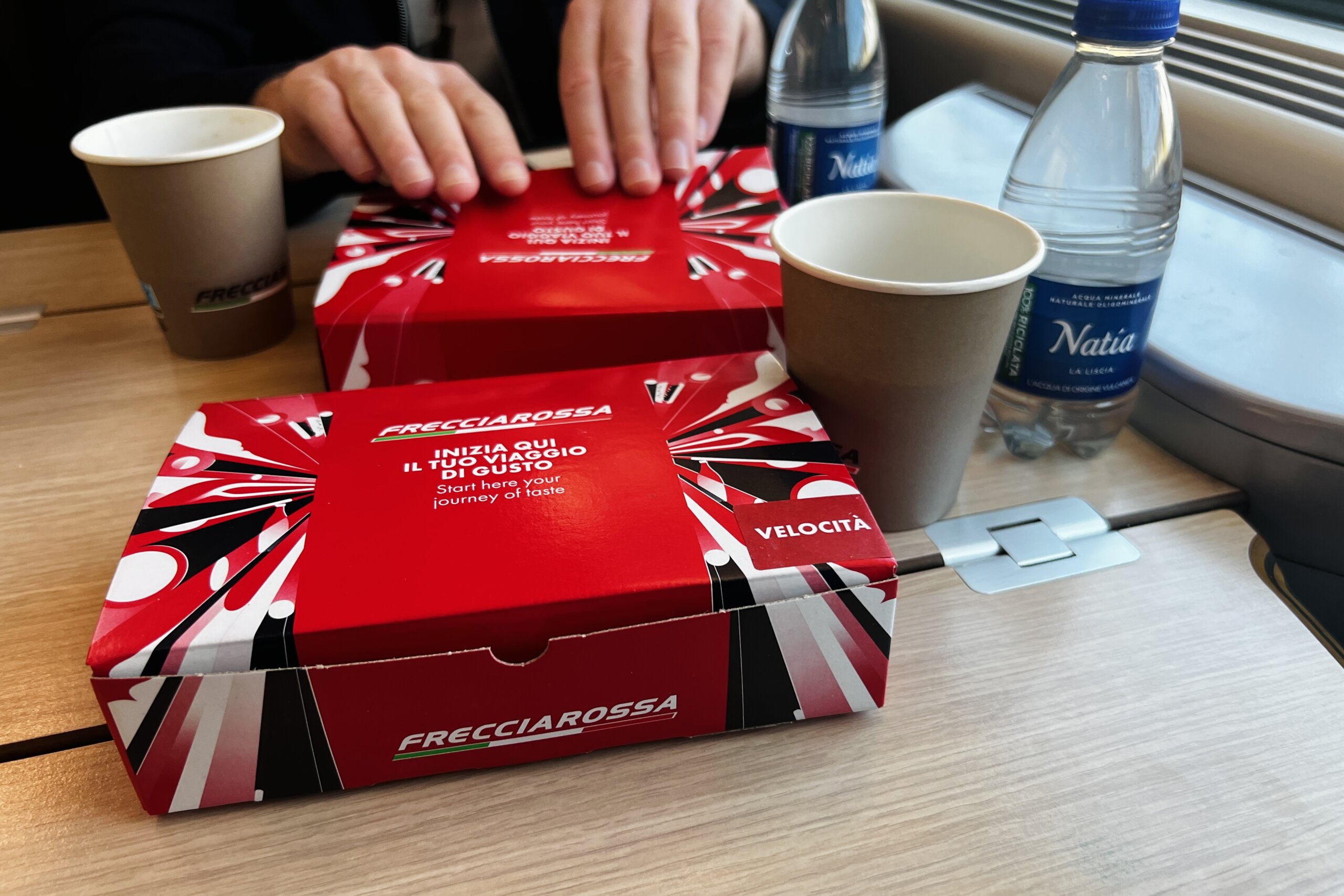
Step Nine: Disembark
If you are not getting off at the end destination, then start prepping for disembarkation about 10 min before your arrival time. This is because Italian trains don’t actually give you much time to disembark, especially at smaller stops! Factoring in time for people to get on board, you really don’t have a huge window of time to collect all your bags and get off the train, especially if there are many others doing the same.
NOTE: I stress this because I have heard a shocking number of anecdotes about tourist families getting stuck on Italian trains because they had too many bags to get and didn’t expect the disembarkation window to be this short.
How do you know when to start packing up? Well, keep an eye out for screens that show the scheduled arrival time/estimated arrival time as well as what the next stop is.
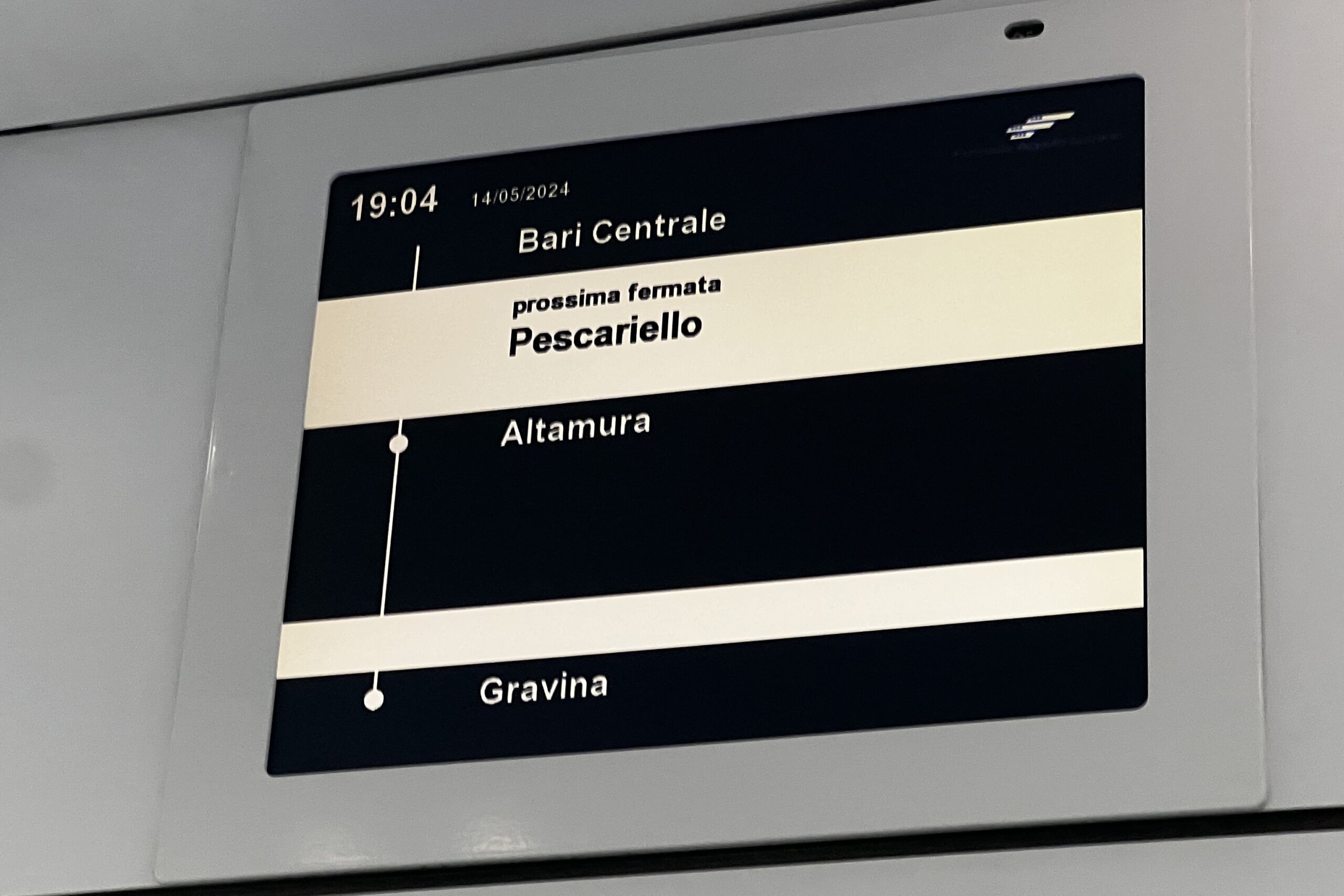
Make sure you memorize the name of the stop you’re meant to get off at because most major Italian cities have multiple train stations and it gets a little confusing once you’re in the city.
Like in Venice, a common mistake is getting off at Venezia Mestre (which is on the mainland) rather than Venezia Santa Lucia (which is the stop you need for the historic Venice city centre).
Upon arrival, if the door isn’t opening then again look for a button with the <> open symbol.

Once the doors are open, be careful getting off the train as there’s often a gap/step.
To navigate your way off the platform and onwards to wherever you need to go, keep an eye out for signs that will point you in the right direction.
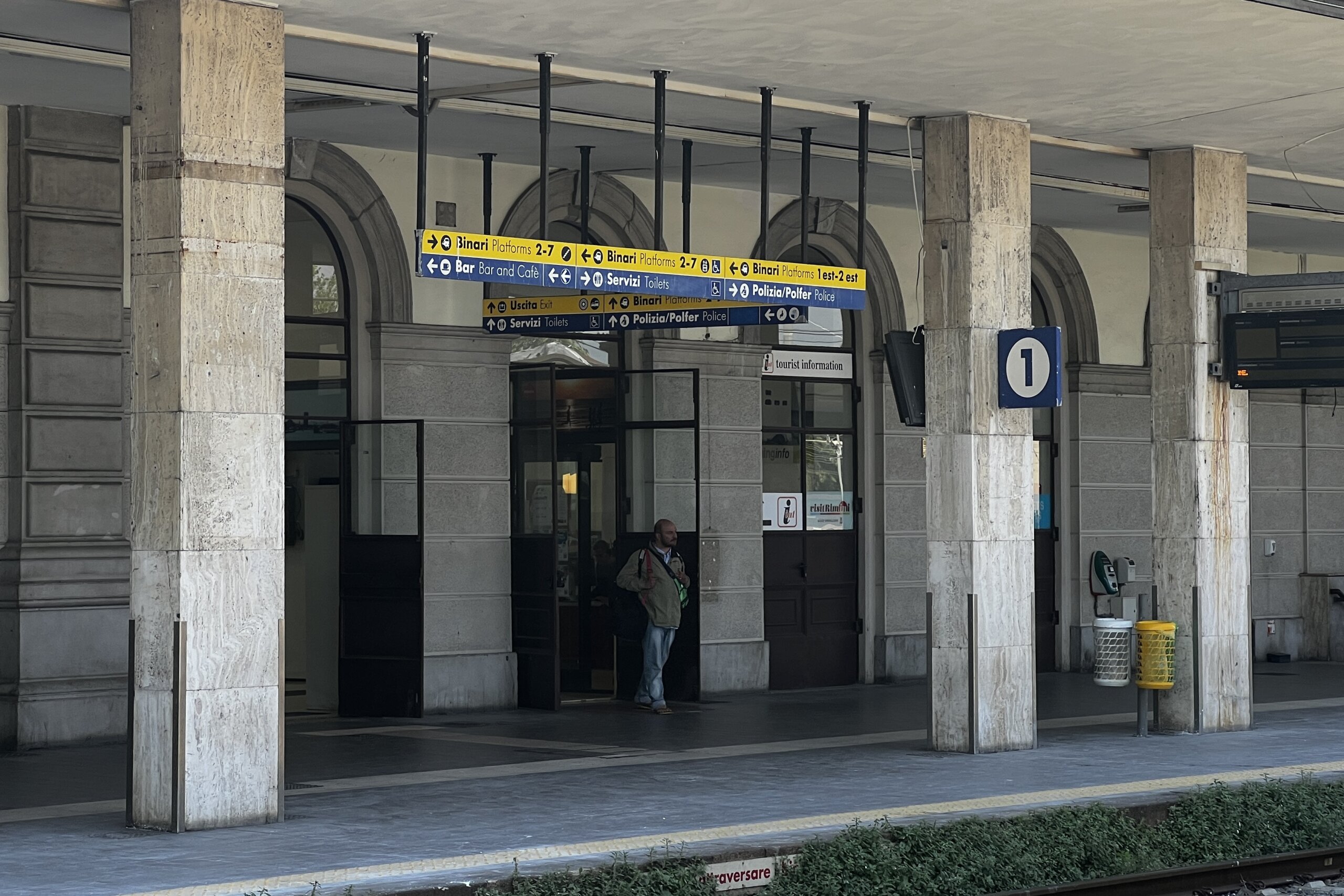
If you are transferring onto another train, look around for big signs pointing to different platform numbers. If it’s a tight connection (10 min or less) you may want to speed walk or run, depending on how big the station is.
NOTE: Remember, you’re on a train platform, so to reach other platforms you need to either go via a tunnel underground or sometimes a bridge above ground. Keep an eye out for stairs/an elevator so you’re not panicking to find ways to reach your next platform.
If this is your final destination but you need a place to drop off your bags while you explore, most major train stations will have a paid left luggage area, which is great if you’re too early to check in to your accommodation, or just dropping in for the day.
Remember that your train ticket is usually only valid for that specific train you boarded, so you won’t be able to use it for onward travel on the metro or bus.
NOTE: In Italy, compensation is available if your train is delayed. The amount and form (whether cash or voucher) depends on the length of the delay as well as what type of train it was. Here is the compensation info for Trenitalia and here is the compensation info for Italo.
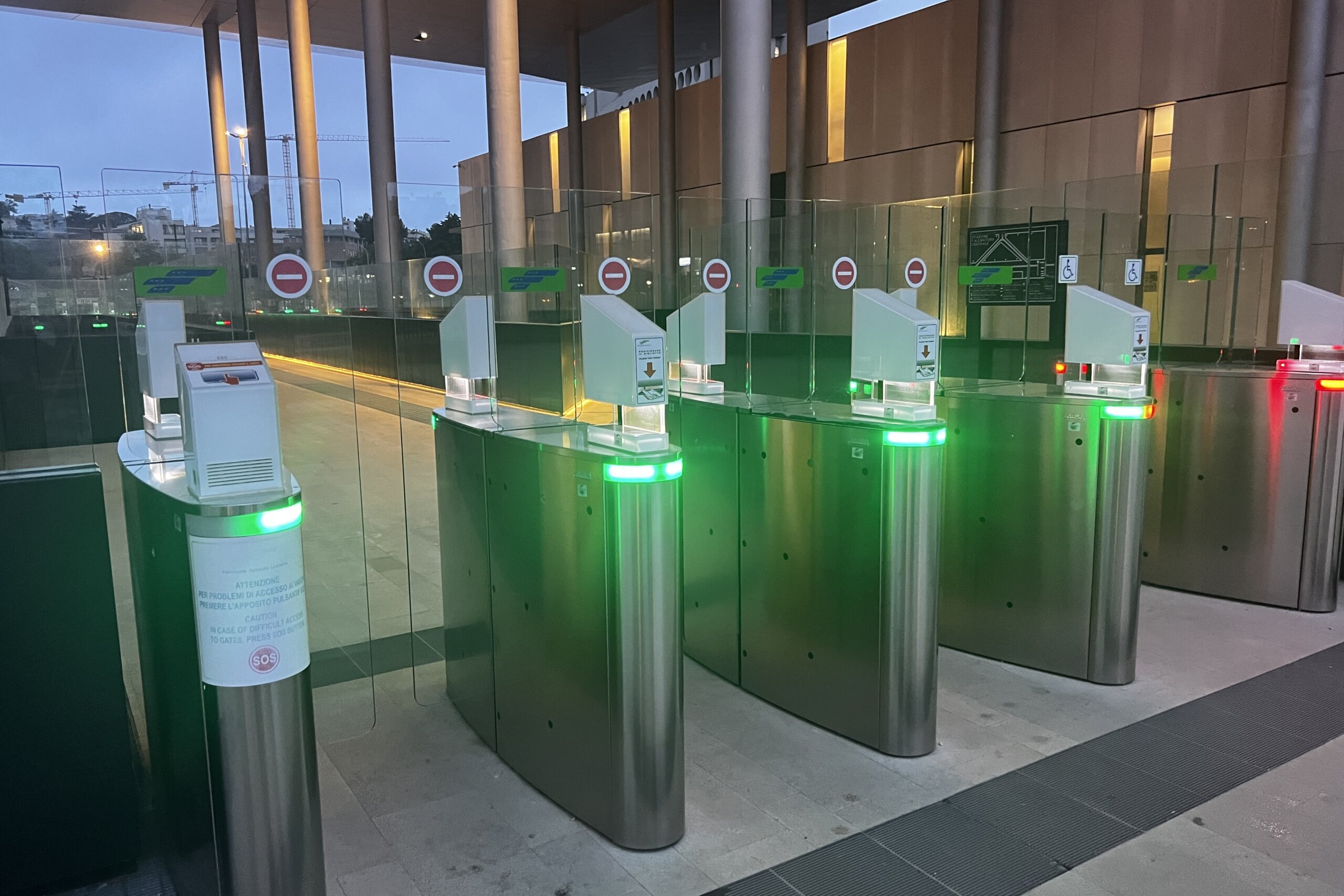
Final Tips for Taking the Train in Italy
Alright, we’ve gone through ALL the basics so now I’m going to simply leave you with some extra bonus tips on how to make the most of the Italian rail system!
Take advantage of special train discounts
If you’re a bit flexible with your planning, it’s worth looking at some of the special discounts available.
Especially interesting for tourists is the …
- Freccia 2×1 – such a great life hack – you basically get two tickets for the price of one
- Same Day Return Special on Frecce trains on Saturdays
- Weekend Return offer, when you depart on Saturday and return on Sunday, you get a 40% discount!
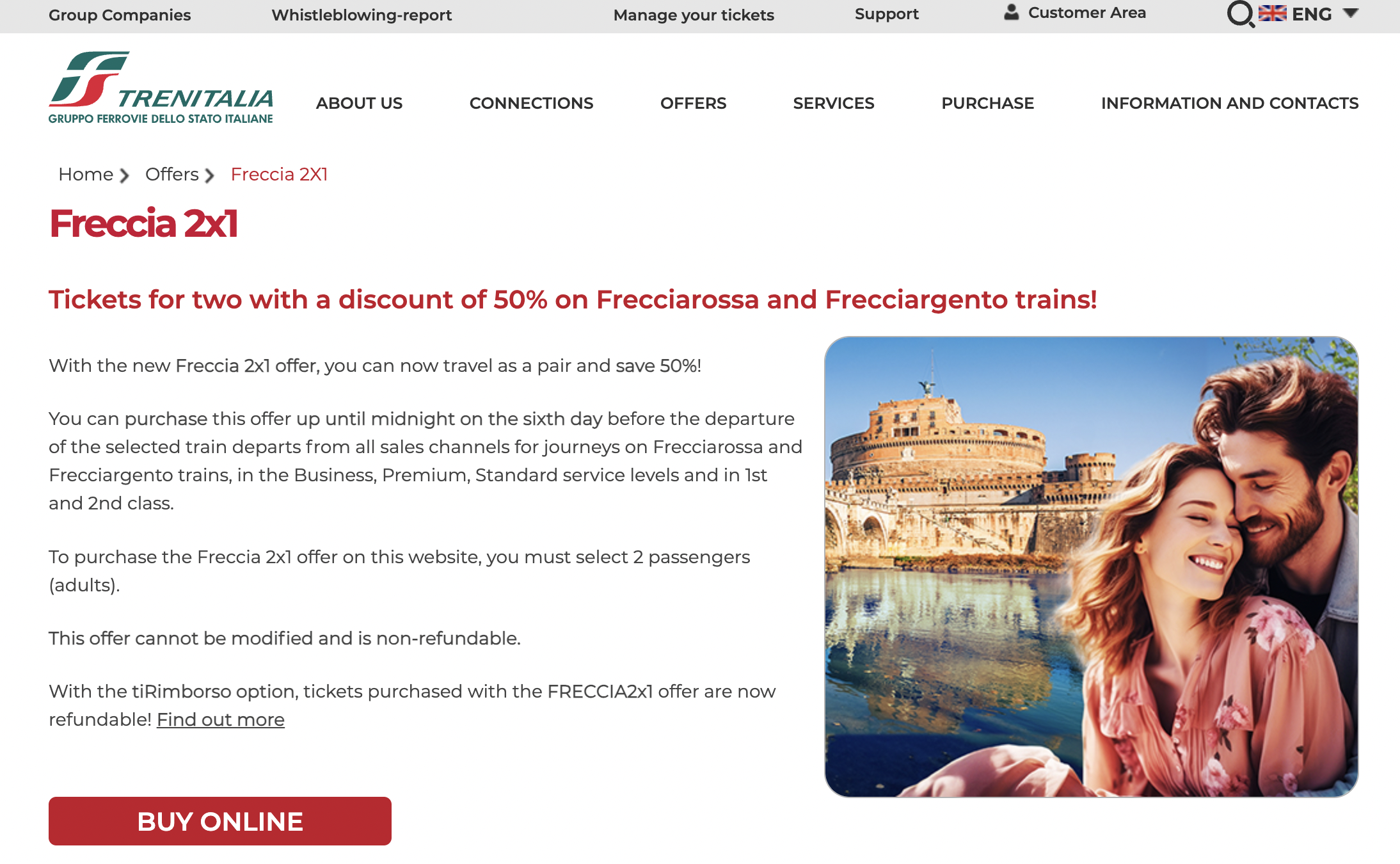
Learn basic train-related vocabulary
Luckily, signage at Italian train stations is usually bilingual, but it helps to know a few basic words so that you can scan signs quicker and potentially ask for help.
So, remember the following…
- Uscita: Exit
- Stazione: Station
- Treno: Train
- Biglietto: Ticket
- Binario: Platform
- Carrozza: Carriage
- Arrivi: Arrivals
- Partenze: Departures
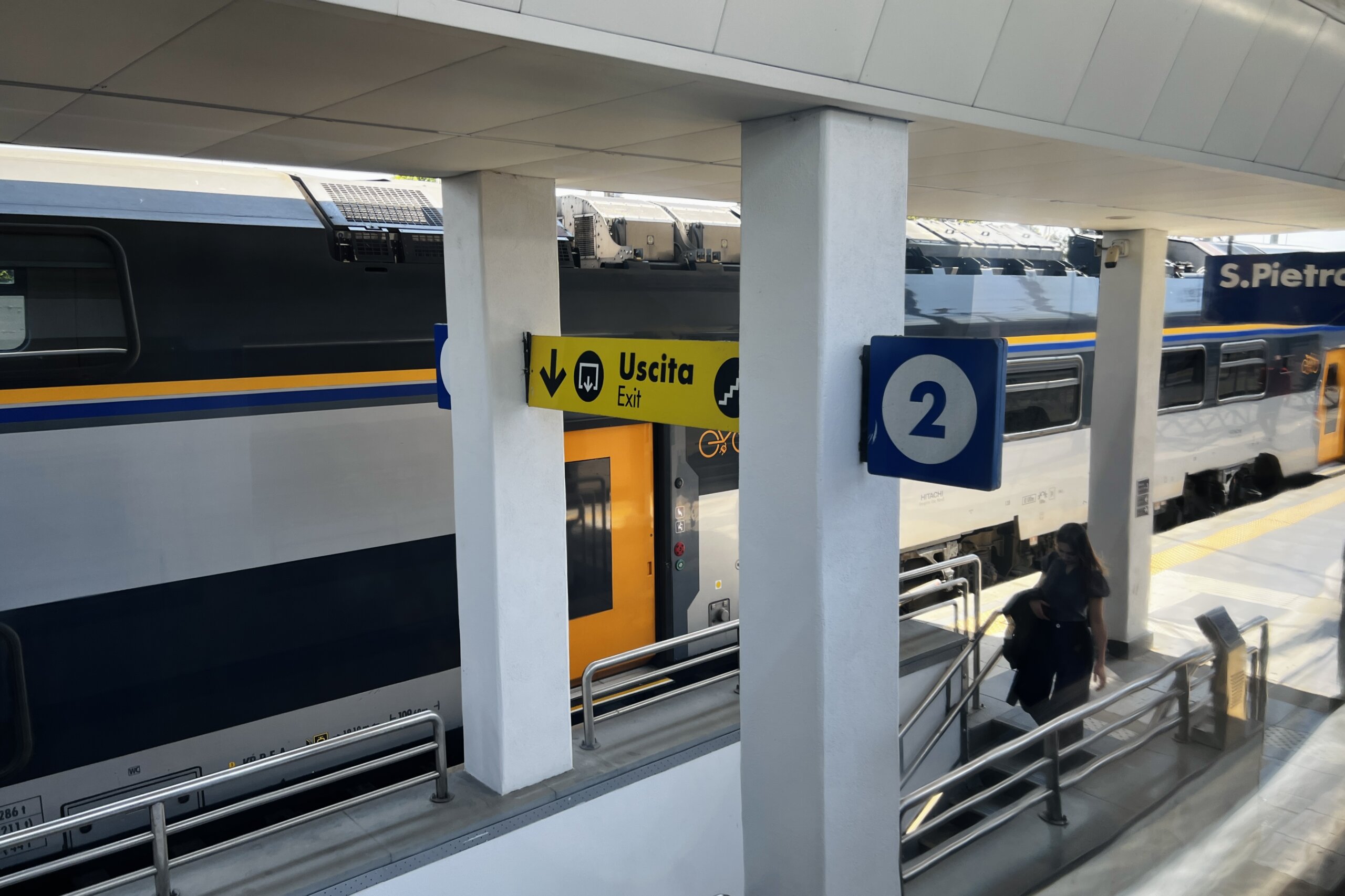
Have a translation app downloaded to your phone
While permanent signage is usually bilingual with Italian AND English, often special notices/temporary signs are only written in Italian so it’s a good idea to have a translation app on your phone so you can figure out what’s going on.
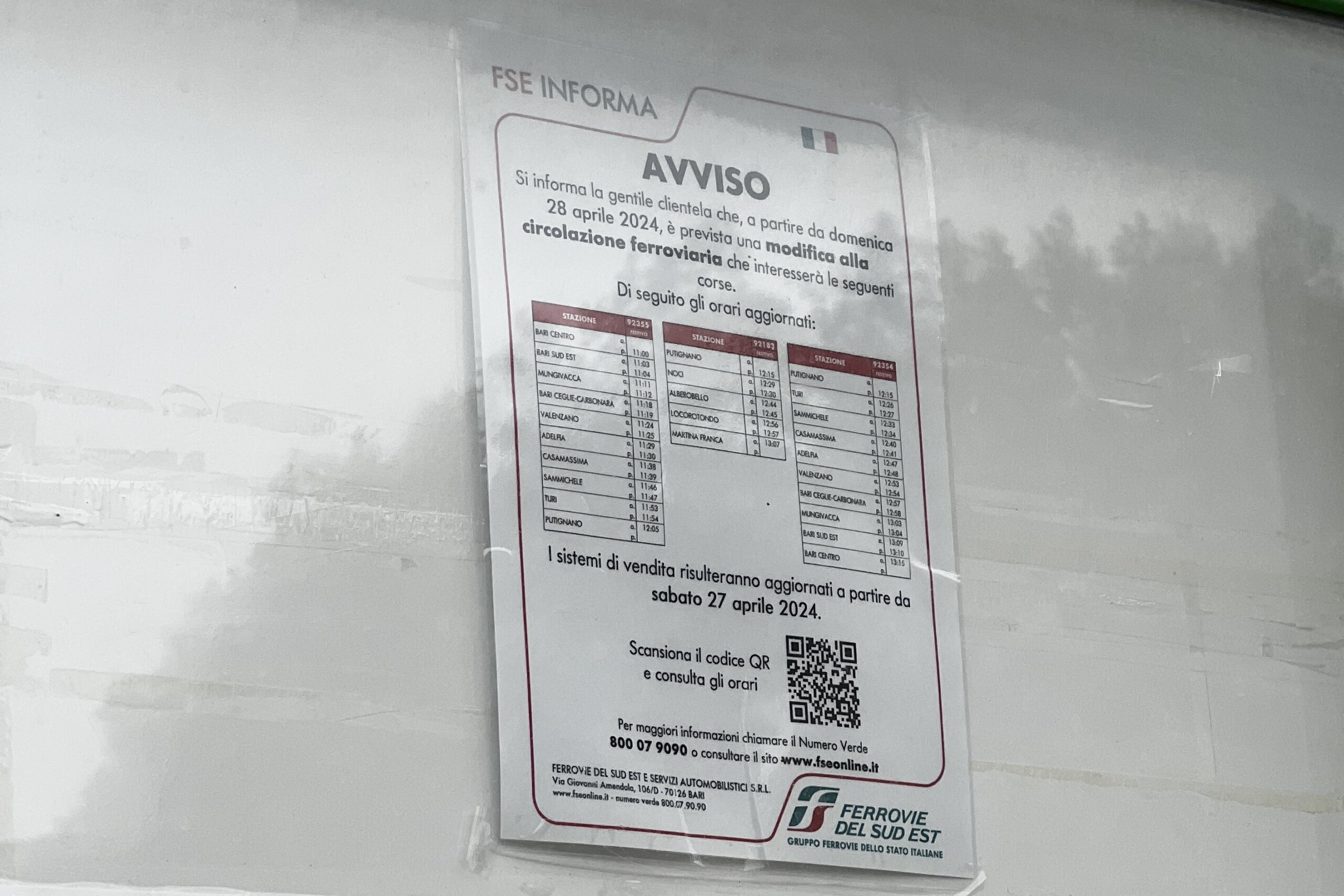
Beware that many Italian cities have multiple train stations
Again, remember that there are different stations in each city, so be sure to clarify which one you are travelling in and out of!

Beware of buses
When applicable, the Trenitalia website and ticket kiosk will also show you buses. To be honest, I would avoid buses if you can! Speaking from trauma perhaps, finding bus stops and navigating bus travel is a lot tougher than trains. This is a special warning to NOT just take Google Maps’ word for it!
When we arrived at Mola di Bari for instance to catch the bus to Alberobello there was a group of at least 10 of us who had all followed google maps to the supposed stop, only to find out too late that on Sundays, the bus leaves from an entirely different stop , a 15 minute walk away. At this point it was too late for us to make it.
So, keep an eye out for the Bus symbol and beware that even machines at the train station can sometimes show the bus as an option.
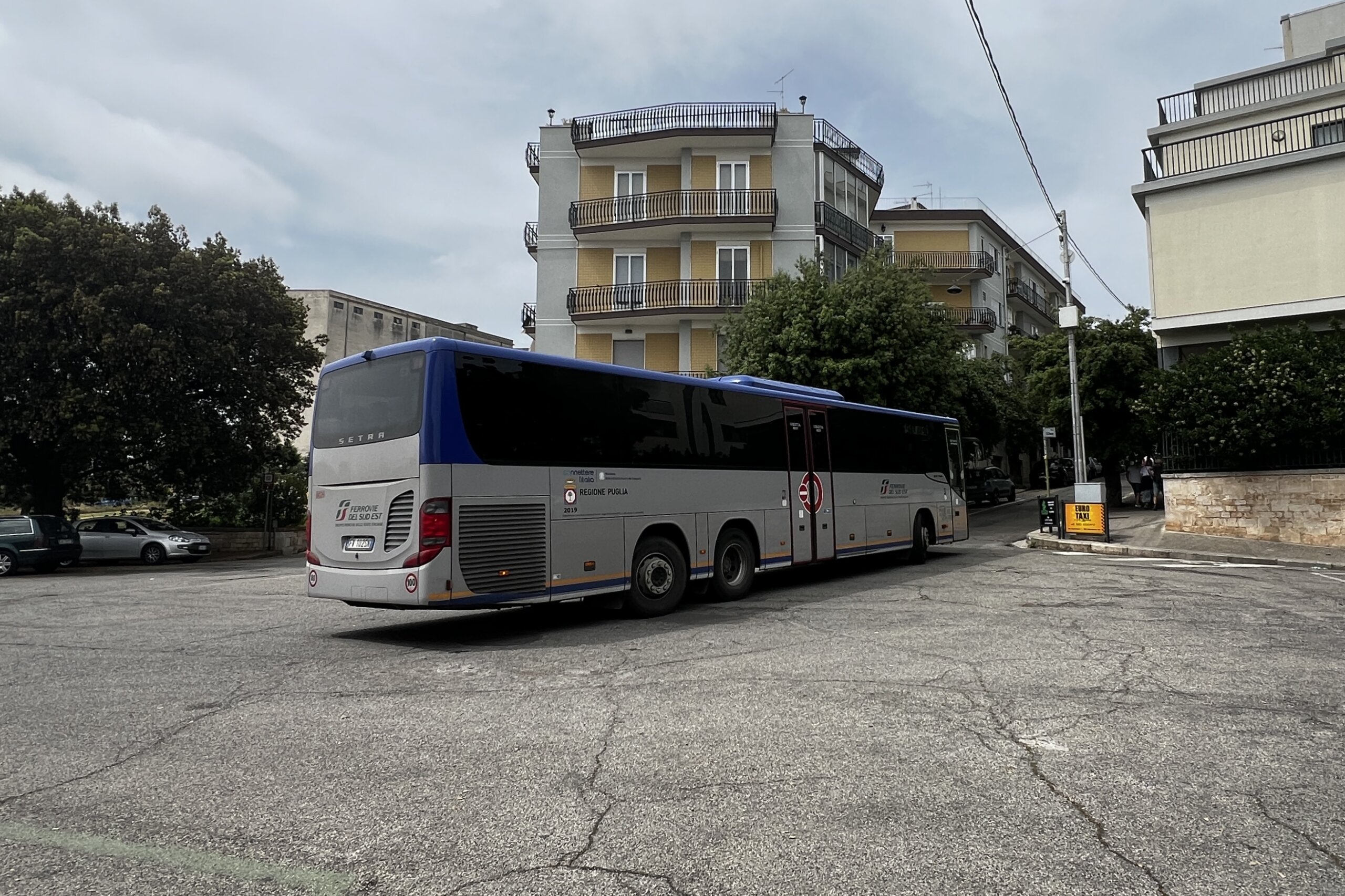
Remember to learn the names of your destinations in Italian
These are the names used at stations/on trains. You will also need to enter these when you buy tickets – the Trenitalia English website for instance will not recognize Rome – only Roma.
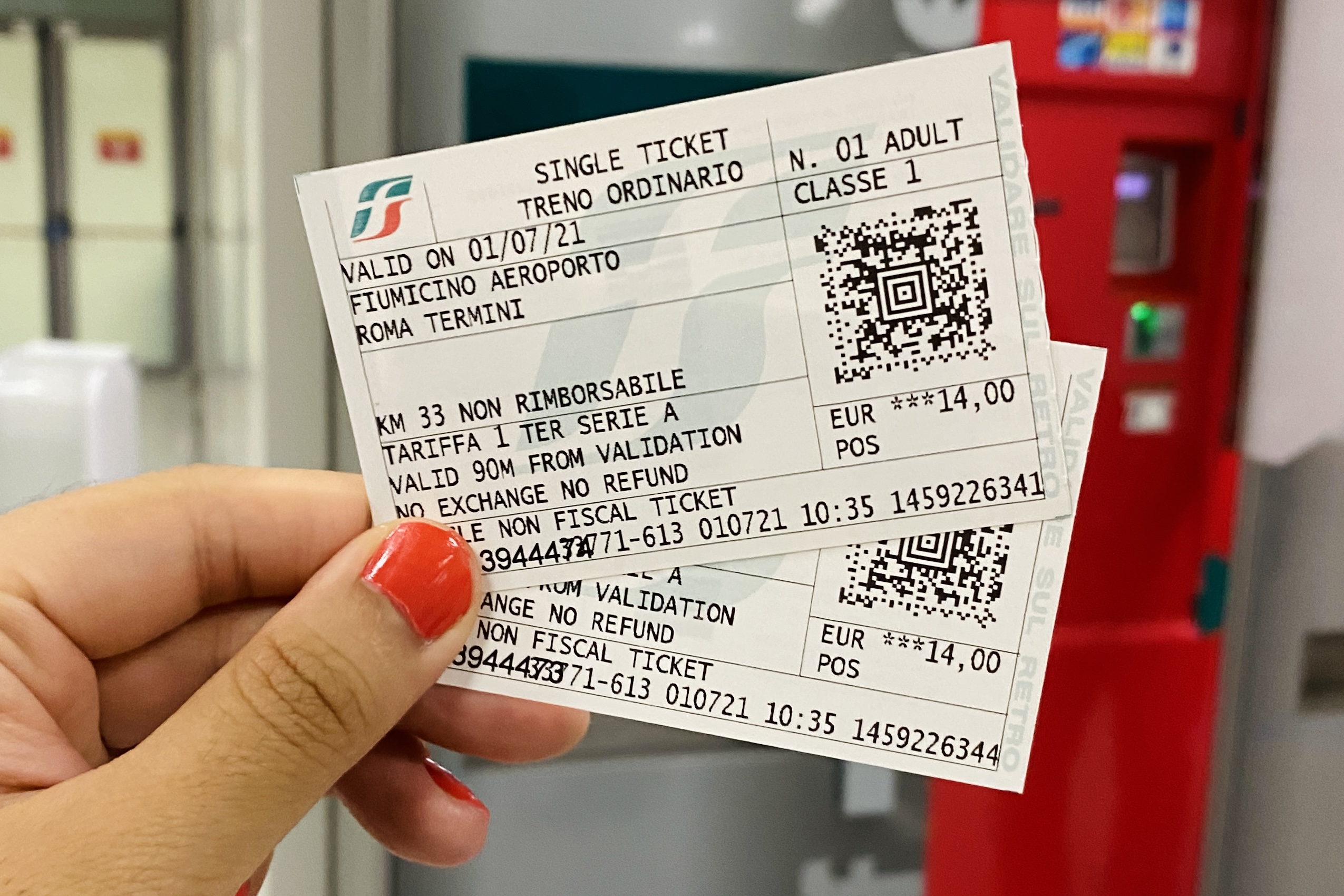
Bring coins for the bathroom
Toilets at Italian train stations are paid and often payment is only accepted in cash, so don’t be caught out!
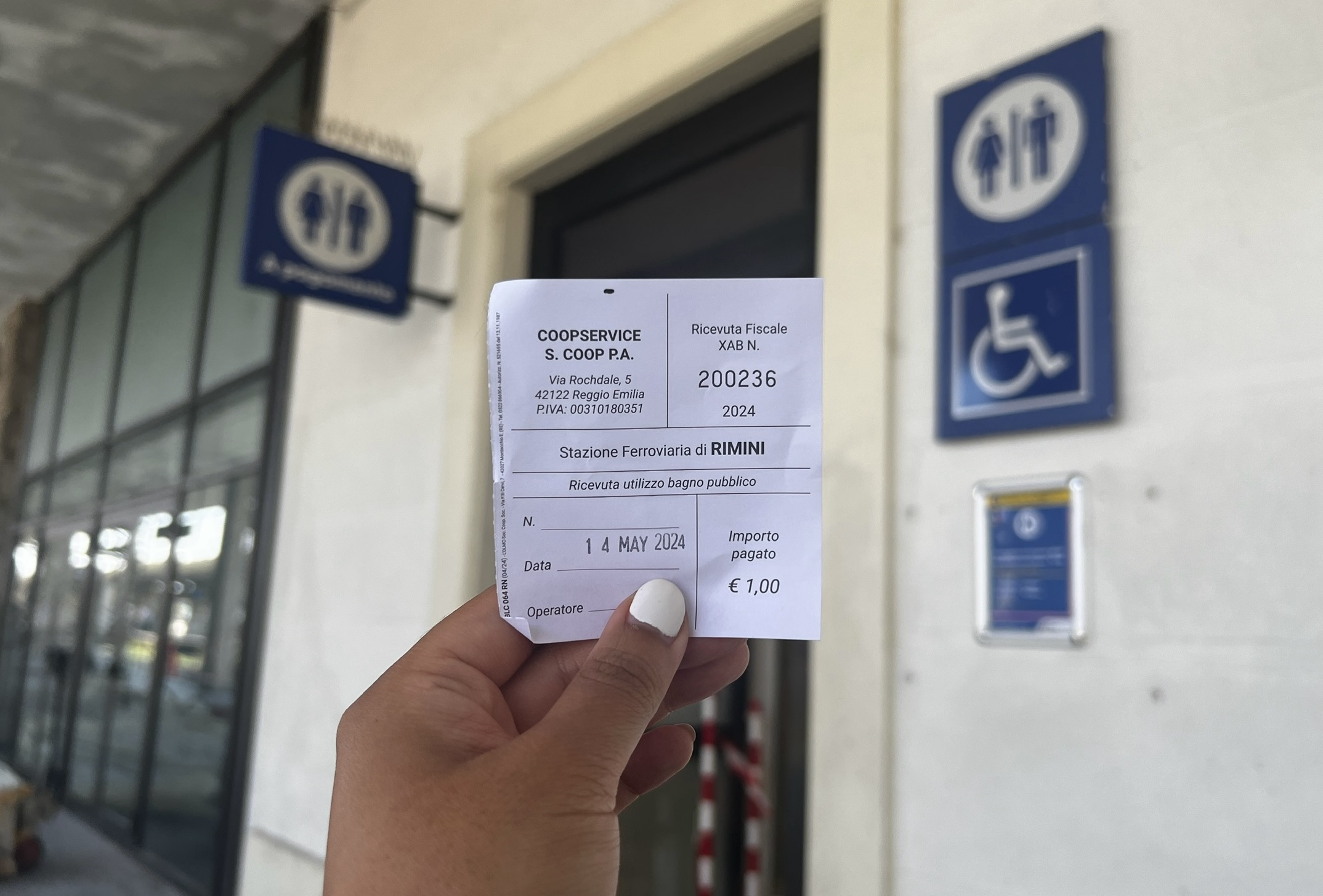
Familiarize yourself with the symbols commonly found at stations
This little legend can help with that:
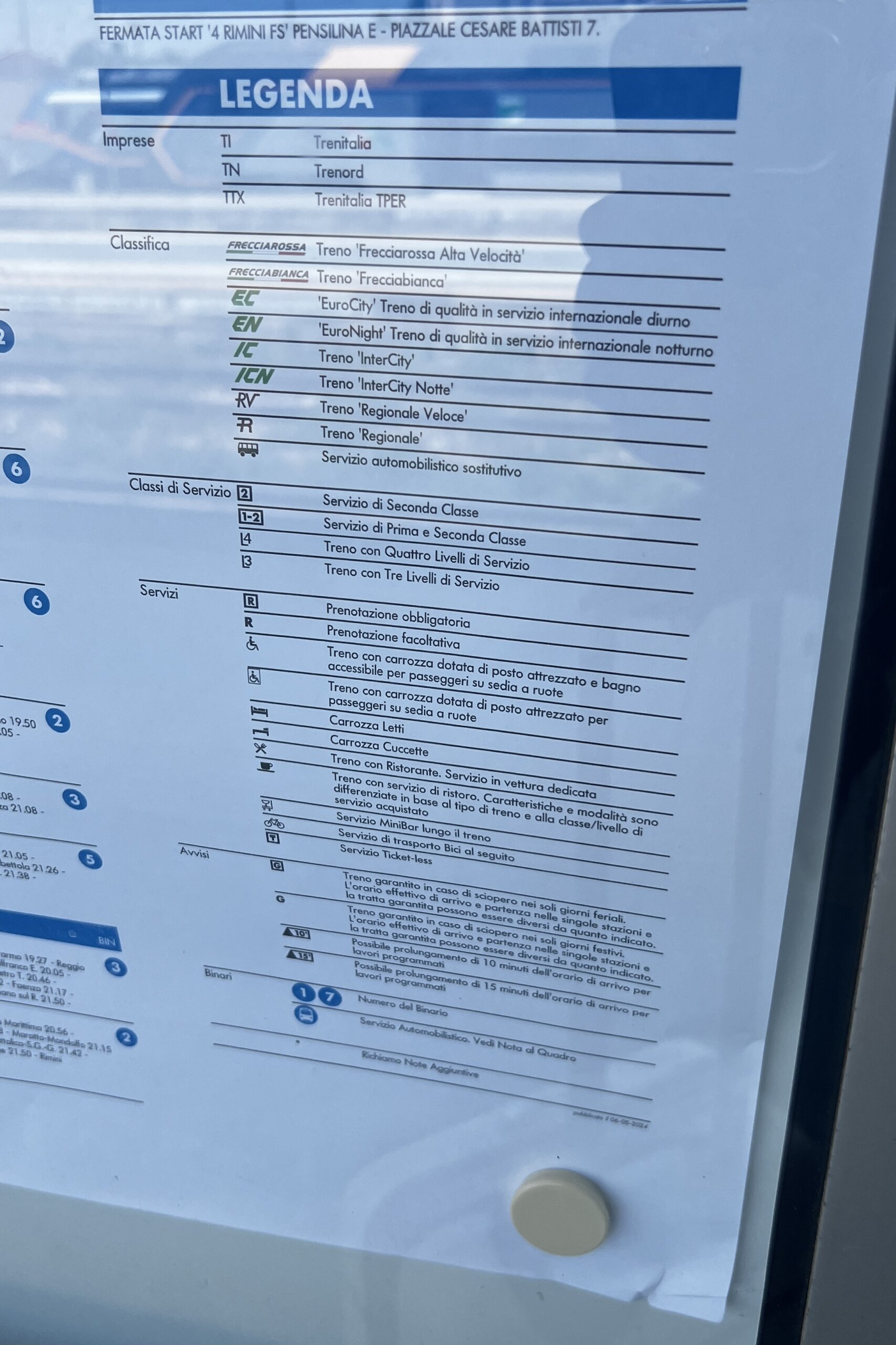
I Hope This Step by Step Guide on Taking Trains in Italy was Helpful!
Let me know in the comments if you have any more questions.

